#but your script needs to hit really particular marks in order to make movies that carry that appeal
Text
i think the main disparity between the dceu movies and the mcu movies is how seriously they take themselves and also the casting
#and it can have a super dramatic effect#not to go all comic movie scholar or whatever the fuck but compare endgame and zsjl#i think marvel goes for emotional connection --> fulfillment whereas dc tries to capitalize on gravitas and weight and shit#and casting has a huge huge huge impact on whether or not u can pull the emotional thing off#but the casting in the mcu (outside of when they like... blatantly whitewash shit) is top notch each actor either embodies#or suitably reimagines their character#but in contrast the casting of the dceu has some awkward spots that contrast the gravitas that they wanna try and pull off#like the casting for lex doesnt make sense in the context of a very snyder-grimdark universe imo#i feel like in this case youd have wanted to find someone who feels more like jlu lex to add to the (take a shot) GRAVITAS#bc the dc universe is fundamentally more centered on LEGACY and PANTHEON n shit#but your script needs to hit really particular marks in order to make movies that carry that appeal#and ironically this focus on legacy is ideally suited to the decades long universe that the mcu has#but i think that comparatively... its a bit easier to make a marvel movie that embodies the sorta marvel vibe#since marvel comics usually feature more flawed characters that are easier to identify with#whereas dc has the kind of people that we aspire to be#and there is a HUGEEE DIFFERENCE IN HOW THOSE PLAY OUT IN LIVE ACTION#oh yeah as i was saying ok comparing endgame and zsjl#endgame (for all its decades long conclusion drama) feels more... casual than zsjl does.... it reminds me of a tv show adapted to a movie#which is actually interesting bc they kinda reversed that effect by making tv shows tht feel like movies.. theyve landed on a formula#ok im out of tags i think hold on
3 notes
·
View notes
Photo

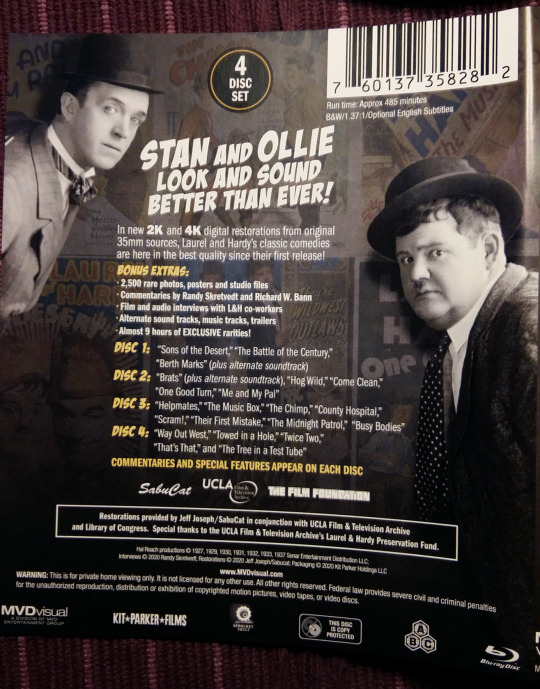
A quick recap of what criticism I remember reading about this Blu-ray set: nobody agrees about the picture quality, or on which films it’s best/worst, but it’s on the waxy/soft side mostly because of too much digital cleaning or whatever, the sound is said to be good, some hissing, out of sync in the 1936 version of Berth Marks, extras are good too, no Blu-ray logo on the case, no booklet, awkward menu always reverts back to beginning, no play-all possibility, the films are not in the order of making/release.
But a lot of people worked very hard for a long time to make this set available. Which is why nothing negative should be said about it? Eh. Next time go for quality instead. Or don’t sell your product. Make it a fanwork.
Anyhow, if I was all powerful and had commissioned someone to restore these films, I’d make them go back and do it again if this set was presented to my ruling eyes.
OTOH, I paid 99 euros for this package and have had lots of fun with it and if there’d been Stan’s scrapbook (pages) amongst the galleries, I’d happily paid double. It’s not about the money spent except when people imply that negative reviews aren’t allowed. I’d paid 99 euros for the galleries alone.
It’s about the fact that the films aren’t as well restored as they should/could be. Beyond me, why it’s so difficult to admit. And it’s clearly not only an issue of getting waxified during some final cleanup or somehow being ruined when transferred to Blu-ray disks.
Any idiot (me) knowing nothing about the processes involved can easily confirm this by watching how different films on the same disk have different quality, likewise first reel can be almost okay, the second much worse, scenes and cuts have often annoyingly varying quality, even single frames look like they came from different prints and nothing was done to make them fit more seamlessly in their surroundings. And I’m not talking about that one wandering frame in Scram!, which must be some person’s idea of a joke, how else could it be so out of place?
Or didn’t anyone watch these that one last important time since it wasn’t removed, nor were the countless spots still there in most of the films? I know, when things get cleaned up that one remaining crumb is much easier to spot... er... see my point?
There are also jumpy frames, which I imagine would’ve been easy to adjust, and to prevent those ubiquitous flashy cuts, you’d only needed to adjust the brightness of that single frame causing the flashing. Even I have done that on GIMP when making gifs. I’m guessing too much contrast on, say, Me and My Pal isn’t a problem created by the wax people either.
The ridiculously softly glowing Brats might be, there’s an awful lot of glowing in One Good Turn too, and in parts of Sons of the Desert, for example, where faces are dangerously close to have that overly scrubbed look, which is a big problem in The Chimp and Come Clean.
When it comes to wax, Helpmates and County Hospital are the most hideous, the latter must be the worst looking of all the films in this set, being also awfully spotty as well as too dark. It’s got other faults too, like wonky frames. The Music Box has a pretty decent first reel (except for the opening scene), and despite not being able to see the stripes on Stan’s and Ollie’s pants because of too much contrast, Me and My Pal is also clearly better wax-wise in the first reel.
It’s interesting to watch some of these films for the first time, thinking that this is crap quality picture, but then the second reel is even worse and suddenly there’s a whole new level of crappiness.
I think the sound is ever so slightly out of sync for a bit in Way Out West and One Good Turn. At least it is compared to those same films on my 21 DVD set. In addition to being very clearly out of sync in that Berth Marks reissue like others have noticed. Berth Marks also has a weird stripey “cover” over the actual film. I suppose it was impossible to remove.
Even with some sync problems, if I had to choose the best restorations from this new collection, Way Out West would be on my list, together with Busy Bodies, Hog Wild and Towed in a Hole. Some parts of Sons of the Desert look gorgeous. With grain and all. Pretty much like Atoll K but unfortunately not as consistently. (Atoll K was restored by different people, I gather.)
The much anticipated but already online for free since 2019 The Battle of the Century then? Well, the first reel is quite good, or would be if it wasn’t a weird blend of an ugly greenish yellow or yellowish green. Sepia isn’t what it used to be. And I would’ve thought they’d made sure to get all those black spots removed at least from this one what with it being one of the “new” things on this set. The second reel is worse except colour-wise. But at least it’s there complete with Charlie Hall and the “what pie fight” ending.
Haven’t mentioned The Midnight Patrol, Their First Mistake or Twice Two yet. The last two are pretty evenly waxy, and comparing The Midnight Patrol to Come Clean and The Chimp makes it not that bad. There’s no actual need to bleach faces or an excuse for Billy Gilbert’s patternless shirt, is there?
For me the treasures from this set can be found on each disk under galleries. Even for those not interested in scripts, press material, posters and assorted documents, there are circa 1,400 photos, many of which really are rare, or at least I’d never seen them before. One of the gems are the about 140 photos from Babe’s Vim days. Awesome! Nothing as gemmy from Stan’s past before Laurel and Hardy, and someone put wrong names on the photos where he appears with the Hurleys, not the Cookes. Yes, there’s a short, handy description for most of the photos.
So many of them and I must peruse more, of course, but I’m going give a special mention to Stan with both Loises on the set of Brats for adorableness and likewise to Thelma Todd for previously unseen (by me) variations from her photoshoot on that bathroom set. Love the six new-to-me photos of Stan and Babe together on the 1932 British tour especially. Great stuff. Oh, and Mae Busch, Dorothy Christy and Charley Chase in their Sons of the Desert portraits look fabulous.
Another treasure are the interviews with only a couple of slightly dubious moments. Joe Rock made me grin. George Marshall made me cry. Walter Woolf King made me laugh. Most wonderful. Short introduction by Randy Skretvedt for each interview. He’s the one who did the interviewing too. There’s 15 of them altogether. Plus a chance to hear composer Marvin Hatley perform Honolulu Baby and Will You Be My Lovey-Dovey. The audio only interviews come with some more great photos.
I kind of adore how Richard W. Bann casually debunks Anita Garvin’s The Battle of the Century story with one dry line during his commentary of the film. Hurts so good. Let’s have more debunking!
Speaking of the commentaries, and maybe more about them on some other occasion, Bann only comments The Battle and The Music Box, all the rest, including That’s That and The Tree in a Test Tube have commentaries by Randy Skretvedt.
I was expecting Bann to tell the whole story of why it took so long to get The Battle on video but he didn’t; fair enough, I thought, but then in his other commentary he goes on about his grudge with a dead guy, so I guess it was not his, um, politeness that stopped him from dishing on the much more recent and therefore interesting stuff. What then?
Perhaps a third person sharing the commentary duties would’ve been a good idea. That was my thought when Skretvedt obsessed over Stan’s smoking for the third time. By obsessed I mean he listed all the films where, according to him, Stan smokes. What for, you may wonder. I did. No answer. I remember reading somewhere that Stan not smoking in the movies means he’s a child. (Yes, some Laurel and Hardy fans are somewhat weird sometimes. Aren’t we all?) Maybe Skretvedt was trying to debunk that theory? Hehe, okay, I know he wasn’t, because he did the “they’re children, Hal Roach said so” routine in his Their First Mistake commentary, complete with Charles Barr quotes to prove there’s nothing gay about Ollie liking Stan more than his own wife. Made me fume. I don’t know why. Nothing new.
I don’t know why it doesn’t occur to him that if Ollie didn’t spend so much time with Stan, Mae wouldn’t be the lonely, disappointed wife who ends up wanting a divorce after one too many lies from Ollie and accuses Stan of alienation of Ollie’s affections. But no, apparently it’s no wonder that Ollie likes Stan more than his wife because she hits him with the broom. So the hitting came first and then too much time spent with Stan? I don’t think so.
Anyhow, third person, more variety, something newer, or at least an explanation for Stan’s smoking being of particular importance. Ollie’s smoking isn’t mentioned. Also, to digress even more, I always found the claim that Stan doesn’t smoke because he is a child odd, not only because he does, but also because he drinks alcohol too and manages to be married in several films. But the Laurel & Hardy child squad of course thinks the wives are actually their mothers. (Yes & again, weird.)
I did and do also wonder if there would’ve been anyone available and even if there had been, if these old school fans had accepted someone with different views. Probably not.
Still waiting for Skretvedt to notice Stan’s camera looks. Maybe he just hasn’t been a fan for long enough yet... 😛
I’m out of steam now. Need to rehydrate.
One more thing: No booklet, so maybe nobody involved wanted to spread about their name more than absolutely necessary knowing the restoration work was, shall we say, uneven?
Tl;dr: Uneven restoration work. Great extras. Mostly interesting commentaries.
10 notes
·
View notes
Text
Griffin Dunne: Who’s That Man? (article from ARENA magazine, Sept/Oct 1987)
Double Exposure: The $4.5 million it took to make Martin Scorsese’s black comedy After Hours and the twitchily neurotic lead performance were both the work of the same man, hybrid movie producer and actor whose next assignments involve the likes of Sidney Lumet and Madonna. David Keeps spends some after After Hours hours with Griffin Dunne.
Griffin Dunne, leading man to Madonna in the soon-come Who’s That Girl, is not the sort of actor who swoops into a photo session with an entourage of managers, publicists and gofers. He enters alone, armed with a briefcase full of business pertaining to the next three or four films he will produce, and introduces himself with a winning humility and, on this particularly sweltering Manhattan afternoon, a perfectly reasonable request for a Budweiser. He graciously and gracefully agrees to a quick bit of barbering and slips into samples from Paul Smith’s autumn collection -- clothes that look very roomy on his slight five-foot-seven frame -- without a fuss. “Are you sure these weren’t for David Byrne,” he jokes. Griffin Dunne is one cool character.
The same can not be said for the neurotic yuppies he’s portrayed in After Hours and Almost You, two critically acclaimed films that were released back-to-back in Britain and helped to establish him as the archetypal Manhattan man. “That’s a coincidence,” he explains over breakfast at a Greenwich Village eaterie a few blocks from his home. “The pictures were actually filmed a couple of years, but I guess if you looked at them as a double-header, you’d see similarities because the main character is New York. One thing I have noticed is that the guy I’m playing always wears a blazer. I’ve got to be careful about what I do next. Those jaded laconic New York type roles are creeping up on me,” he continues, his almost-black eyes widening as his voice rises in mock terror. “I may never work again and die a pauper because these two pictures are so much alike!”
Now there’s an unlikely prospect. Having successfully produced Chilly Scenes of Winter, John Sayles’ Baby It’s You and Martin Scorsese’s After Hours, Griffin Dunne is in the unique position of being able to pay the bills and choose his acting roles carefully or develop properties for himself. The latter is an option he has exercised only once (After Hours), the former is an admitted luxury. “The problem with success is, the more successful you become, the more careful and calculating you have to be. While I dread being an actor and never knowing where my next job will be coming from, there was a great freedom in going from one stupid comedy into a play in some no-name theatre down on Pitt Street in lower East Siobokia. I get sent a lot of scripts as a producer and I don’t want to spend my time looking for parts for myself. I have an agent to do that. But that still doesn’t give me the opportunity to pick up the phone and say ‘Get me a script that is completely different from anything I’ve ever done, and I want to start working Wednesday’. “
There was a time when the very prospect of working in films - as an actor or a producer - was something to be avoided. Born in New York City on June 8, 1955 to actress Ellen Griffin Dunne and Dominick Dunne, who evolved from a television stage manager to a producer and now, a writer for Vanity Fair, Griffin was raised in Los Angeles amongst the privileged sons and daughters of Hollywood. He attended a pre-preparatory school at age 11. “All boys. You wore a coat and tie and got little swats if you got out of line. It was called Fay School,” he recalls with a shudder. “It was a bitch to say ‘I go to Fay School’.” He turns his head to the side to improvise a dialogue and with a sneer asks himself sarcastically, “How’s Fay?” “Fine thank you,” he mumbles, suitably humiliated. In his final year it became his job to order films for school entertainments. His very appropriate choice was Lindsay Anderson’s public school drama If... “It was a real underground thing. The attendance rate was incredible. They were hanging off the rafters. If you know the picture you know it takes them forever to kill those fucking teachers!”
The Fountain Valley school in Colorado proved a more nurturing atmosphere for the lad. Influenced by his uncle and aunt (the literary lions John Gregory Dunne and Joan Didion), Griffin thought he would become a writer. “I just knew that film business was the last thing on earth I was going to be in. It’s like if your father goes to work in a car factory in Detroit, the last thing you want to do is go into the automobile business. I didn’t sit in judgement of Peter Benchley’s (OP NOTE: author of Jaws) drinking habits, but it was just too close to me. I was really verbal about it. Openly vitriolic, I would never be in show biz. I said that right up until a friend talked me into auditioning for this play.”
That was Edward Albee’s The Zoo Story and Griffin knew instinctively that he was the best man for the job. “Somehow I just knew I could say these lines better than anyone else. It was like being the only one in that room who spoke that particular language.” An actor was born and a bullshit artist began to operate. “I was the guy who ran the drama club, the art paper, the student council planning board. Teachers treated me like an adult, they really thought I was going places. They said ‘You’re not like the other students.’ I was, of course, a source of total disappointment, because I was exactly like the other students. I would get high and take the car off campus and try to get laid at every possible moment as soon as their back was turned.”
Then, just as he was about to make a dramatic triumph playing Iago in Othello, he was busted. “Got caught smoking a little hash,” he winces. “All that was really there was what was in my lungs and it just trailed out of my mouth as I denied what was happening. And the teacher did not get a contact high and forget what he was doing. What they were saying was, ‘We’re going to change the rest of your life for that amount of smoke in your lungs’.” He was sent packing, forced to face up to parents who were “grief stricken”, he says with a comic frown, “chopped off at the knees.” Convincing the school authorities in a brilliant final thespian act that he needed to take the bus home in order to have time to think about his misdeeds, he hit the highway and hitchhiked home.
The odyssey that followed could’ve been a foreshadowing of the hassles that befell him as the stranger-in-SoHo in After Hours. “I was very worried about getting into any more trouble. And every car I got in was the most troublesome, criminal car. One guy would be driving a huge Cadillac convertible that he’d bought with a bad cheque. Another guy was AWOL from the army and there was this kid who’d just left ‘Juvie’ (Juvenile Hall) who was only a year younger than me, but also about four feet shorter. We’d spend a good deal of the time daring him to do things like climb out of the hood of the car to straighten out the antenna as we were crossing the desert. As soon as he got out there the driver would floor it, going about 95 miles an hour and swerving to throw him off. I thought, ‘OK drug possession, hot car, and manslaughter, all on the way home. Look at it this way, Mom, Dad, I was only kicked out of school for smoking hash!”
He lived in Los Angeles for the last gasp of his teenage years, working in a bookstore and as a shipping clerk for a cooking utensils firm, while going for auditions that were few and far between. After a few small roles on TV, he moved to New York to study at the Neighborhood Playhouse, where, ironically, in the days before Dustin Hoffman, Griffin’s father had left his studies when he was told that he was too short to be a leading man. Though Griffin was spared the same advice, he worked more steadily in the restaurant trade - even selling popcorn at the candy counter of Radio City Music Hall - than he did in the theatre. Then he met Amy Robinson and Mark Metcalf (OP NOTE: misprinted with an e), two equally frustrated, equally unemployed actors, and the trio decided to become producers.
(OP NOTE: Since Dunne, Robinson, and Metcalf were/are baseball fans, the original production company’s name was Triple Play Productions. When Metcalf left to focus on his acting, the company was renamed Double Play Productions).
“We went out to Cambridge and met Ann Beattie, who had written Chilly Scenes of Winter and she said it was like three of her characters walked into her living room.” Not surprisingly she allowed them to buy the rights for a film version at a very reasonable price. At age 23, Griffin Dunne had become a producer and had his first property. The trio turned the process of pitching the project to studios into an acting exercise. “It was exactly like a performance, but it was easier than going in on an audition. Here I had something tangible to sell, a book that I was passionate about. It’s hard to do that about yourself. What do you say? ‘Look at this interesting aspect of me. Then if you shade it with these particular attitudes I look like this!’ I wouldn’t want to see anybody do that.”
First released as Head Over Heels, and re-released more successfully in 1982 under the author’s original title, Chilly Scenes of Winter set the stage for the fledgling producer’s next triumph, John Sayles’ Baby It’s You, which introduced Rosanna Arquette and Vincent Spano to a large and appreciative audience of young filmgoers. In the meantime Dunne had appendaged several screen acting credits to his dossier, largely of the messenger boy variety.
“I’ve passed a ton of envelopes,” he laughs. “In this one film, The Fan (a potboiler starring Lauren Bacall as the intended victim of an overwrought admirer) I played a stage manager who was to hand a letter the killer gave me to Maureen Stapleton. The letter read ‘I’m going to kill you, I’m going to kill you,’ and sure enough he does. So they spend the rest of the movie looking for the killer instead of asking me for a description. When I told the director, he said ‘Yeah, well, fine, can we just shoot the scene please?’ So I just couldn’t resist on one take. I went up to Miss Stapleton and I said, ‘Here’s a letter from the killer -- oops! -- I mean the man outside’.”
He was able to use his comic gifts more successfully playing the sidekick role, “the very dead one” in An American Werewolf in London (OP NOTE: Title misprinted without the ‘An’) and the clean-cut brother of a gangster in Johnny Dangerously, “a big silly comedy.” Then a script crossed his desk which he simply could not ignore, for it contained all the elements he looked for in a film as both a producer and an actor. It was called After Hours, and it was the tale of a lonely word processor who meets a beautiful girl, loses her, loses his money and his house-keys and spends the rest of his evening on the run from assorted temptresses and loonies in the lofts and streets of New York’s SoHo.
Griffin Dunne was no stranger to the inherent weirdness of such a scenario. “Last weekend I was out of town and a friend was in my apartment. I said don’t use the bottom lock. She did, and so I was locked out of my own apartment. I called my neighbors to let me in, but they were locked out of their apartment too. I found that out from the neighbors below. The owners are from Japan and they’re coming to get their apartment from me. I’ve now been through so many locks it looks like a Uzi got at the door. The locksmith is now an old friend of mine. I have the worst time with keys. I believe the first stage of manhood is when you live on your own and you’re given this set of keys. I’ve been through so many keys. They just leap out of my pocket!”
Griffin Dunne became After Hours’ hapless anti-hero Paul Hackett and his run-ragged energy leaped off the screen. Despite the fact that the entire film was shot at night, director Scorsese demanded that he remain celibate during the course of the shoot. For added punishment, Dunne himself also acted as the film’s producer: “As an actor your job is not to have distractions and be in a loose state where, when things are thrown at you, you can react accordingly. As a producer your job is to constantly anticipate problems, disasters, flare-ups, fiascoes. You’re in a constant state of tension. You have this little rubber ball with spikes sticking out of it in the pit of your stomach. In After Hours if there were times when it was five in the morning and I was starting to run out of anxiety adrenaline, I could think of how much the picture was going over-budget and I would suddenly get this hollow look in my eyes, my eyebrows would start creeping up on my forehead and I was ready to roll! But I never as an actor looked at the director and thought, ‘Gee, he’s shooting too much film, I must tell him to stop.’”
Though After Hours was a huge critical and commercial success, it pointed out some rather disheartening facts about the American film industry. “People are so obsessed with how much pictures cost. It really pisses me off,” he says with a furrow of the brow that makes you an instant sympathizer. “All anybody talks about with After Hours is that we made it for $4.5 million.(OP NOTE: $4.5 million in 1985 would be about $10.8 million in 2020) Who cares? Is it a good movie? Is it a bad movie? For some reason English films have avoided that. Probably because they were made with pounds instead of dollars and the critics are too lazy to figure out the currency conversion.”
Now he’s on a roll and it becomes quite clear that Griffin Dunne, as an artist and as a businessman, cares about the cinema passionately. “There are a lot of [OP NOTE: misprinted as off] young filmmakers trying to get off the ground here. It’s treated so condescendingly,” he splutters. “Those kids made that Personal Art film. Art film is a bad word for everybody - it’s a personal film. Or it’s an independent film, which must mean it’s personal. ‘Those kids made that picture and just look what they did. And their grandmother gave them $2.5 million for that?’ I don’t think it was their grandmother,” he continues with a lethal iciness. “I think they went to a major financing entity and they got the money, it’s playing in theatres now. GO SEE THE GODDAMNED MOVIE!”
(OP NOTE: Sir, this is a Wendy’s. All joking aside, I would love to hear the off-the-record version of this rant)
All of this seems particularly annoying to a man like Griffin Dunne because he’s proved that it can be done. “It’s just treated like it’s so cute. Now it’s possible to make films like Mona Lisa, Withnail and I or one of Stephen Frears’ movies in the States. There’s a lot more avenues of finance and they’ve figured out ways of distributing movies where they actually make serious money and it’s easier for people to get their money back on videocassettes and all the other rights. What we’re having a little bit of a problem with is the material itself. How do you find a script that doesn’t reek of being an Independent Movie?”
In Adam Brooks’ Almost You, which was written as a vehicle for Dunne and his then-girlfriend Brooke Adams, he found exactly that. An offbeat comedy about an adulterous husband, the film was warmly received in Britain after having been crucified by the American press. (OP NOTE: As someone who enjoyed that movie, I think the reason for that is because British audiences are more comfortable with unlikable or dysfunctional protagonists than American audiences. Also, this was the Reagan era with traditional values and all) “I found the character very touching and pathetic, but when it came out you would have thought I was a war criminal. An immoral louse. The worst of it was they would never say my character’s name. They would say ‘Griffin Dunne is a duplicitous, weak-willed human being!’ People fuck around on their wives, what can I say? The way people went on, because I fooled around when my wife was in a wheelchair, it was like one of those Reefer Madness kind of movies. Like I was condoning it,” he says, lapsing into a sinister’s narrator voice, “C’mon kids, go out and smoke heroin. And while you’re there get married and fool around on your wife who’s in a wheelchair. Come with me to...THE MOVIES!”
His next screen appearance should raise the stakes considerably higher and may establish Griffin Dunne as a solidly commercial leading man in romantic comedies. “I’d known about the script for years,” he says of Who’s That Girl. “It was the first screwball comedy I’d read that wasn’t a rip-off or a parody . The characters were really contemporary. Over the years I just slowly watched it get put together, slowly, slowly coming around to me. I had a feeling it was going to work out and I have that feeling very rarely.” It’s the story of one Loudon Trott, the standard “uptight kind of guy” whose world is thrown into utter chaos by the appearance of a dizzy but dazzling vixen. “I’m one of those inside-the-little-globe-there’s-a-madman-dying-to-break-out characters. But I was going as much against the nitwit-nerd as possible. I wanted to wear the best suit I could find. I look unlike anything I’ve ever looked before. You don’t wake up with hair like what I’ve got in this picture. I don’t even know what the hell I look like.”
The vixen is, of course, played by Madonna. “It was externally pretty crazy,” he says of the shoot. “A lot of paparazzi and fans. I guess for my survival I just shut it out. It didn’t bother her, so why should it bother me? If it bothered me it would show on the screen, but nobody would say, ‘Gee, he doesn’t seem to be there right now, it must be the fans.’” He laughs at the very thought of it. “I’ll fight for a disclaimer at the end of the picture!”
He’ll have to juggle his next acting assignment between efforts as a producer. Running On Empty, the coming-of-age story of the son of Sixties dissidents living on the lam, is set to be directed by Sidney Lumet with River Phoenix in the leading role and Robin Williams has been signed as the lead for a Disney-financed version of the stage comedy The Foreigner.
[OP NOTE: While Running on Empty was eventually released in 1988, garnering Phoenix a Best Supporting Actor nomination at the Golden Globes, The Foreigner never materialized. I’m sure there’s some amazing stories that have yet come to light on the latter].
And industrious though he may seem, Dunne admits that he’s really good at not working, too. “It’s a talent that I’ve evolved over the past year or so. When I’m not working it never crosses my mind. I’m into maps. I’ll chart a trip and get a really good radio in the car, record a lot of tapes and hit the road. I’m really good at getting out of town and going to the beach. My problem has been collecting a lot of things over the years, but I’ve lived in sublets for the past 11 years, so I haven’t been able to settle into any pattern yet. Now that I’m moving into my own place, I’m glad. I’ll have people over so they can admire my spoon collection from my various journeys and I’ll even have shows. I will promise to bore them senseless with my passions.”
It’s unlikely he’ll be able to make the same claim in a professional capacity; his involvement on both sides of the camera and casting office have certainly produced an exemplary cross-breed of moviemaking professional, one that box office superstars-cum-executive producers of their own vanity projects could most certainly learn from. “One of the things I like about being a producer,” Dunne explains, “is that it’s opened me up on how to read a script. I like to think of the whole picture now, not just my role.” But having an awareness of what makes a film succeed in an increasingly byzantine business has not dulled his enthusiasm for acting, nor dimmed his onscreen spark. “It still is fun,” he demurs. “It should always be fun to get paid for taking fencing lessons.”
Always a wit, Griffin Dunne does seem most comfortable making a joke, even if it is at his own expense. Asked which of his screen characters he’d feel closest kinship to in real life, he deadpans, “I use so much of myself in them that I can’t imagine wanting to hang out with any of them.” And he’s equally nonplussed about his reputation as an independent force in the motion picture industry. The man simply has taste and if he likes to wear as many different hats as he can in this business, well, that’s his business - and he’s certainly very modest about his accomplishments.
“It’s difficult,” he concludes. “for me to say ‘I’m a rebel. I’m a maverick’ and put on little cowboy hats and stroll out of here into the sunset.” Especially, we both agree with a laugh, since it’s not even high noon yet.
7 notes
·
View notes
Text
Dragon Ball Z 036
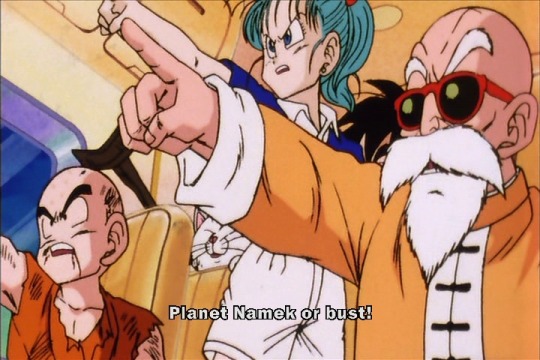
It’s the Namek Saga! I have mixed feelings about this arc, and I’ll try to explain them.
So I got into DBZ when it first aired on Toonami in the fall of 1998. I don’t recall exactly how it was aired, but I’m pretty sure they showed four or five episodes a week, every week, until they got to the Goku/Recoome fight, and then they would start over. Somewhere along the way they aired Movies 1, 2, and 3.
Now I was just a casual viewer in those days, so I wasn’t going out of my way to watch them in order. I didn’t exactly like the show much; I just watched it because it was on, and I was sort of curious about what would happen. The Saiyans arc impressed me because it did a good job buildng suspense. But you could skip a few episodes and not really miss much. There were plenty of recaps, and not that much happened in any single episode.
The Namek Saga had some trouble following this formula, though. Once the heroes got to Namek, it was hard to really measure any sort of progress being made. The overriding strategy was to stay in one piece until Goku arrived to even the odds, except the supporting cast was pretty threadbare by this point. They couldn’t exactly kill anyone off in the Namek Saga, because they had killed so many guys off in the Saiyans arc, and if you took out any more there wouldn’t be anyone left to tell the story with. So it felt to me like much of the arc was just the gang marking time until Goku showed up.
And this wouldn’t have been so bad, except that whenever Goku finally did show up, he’d punch Recoome’s lights out and that would be it. Toonami would run out of episodes and start over with Episode 1. I remember at least once when I was kind of following more closely to see if they’d finally put some new eps in the rotation, and then... no such luck. Goku shows up, whoops the Ginyu Force, Bill Murray wakes up in the hotel room to “I Got You, Babe.”
I feel like this has colored my opinion of the arc. I was trying to remember exactly what I didn’t like about it, and my criticisms aren’t really all that valid. “It’s too long,” but it isn’t. It’s 32 episodes long, and that’s three episodes shorter than the Saiyans Saga. “There’s no big fights,” but there are. Vegeta vs. Zarbon is pretty cool, and Recoome smacking Team Three Star around is fun. “It’s unsatisfying,” but not really. Frieza gets extremely pissed as the arc wears on, and Goku shutting down the Ginyus and Vegeta at the same time is awesome.
For a time, I struggled with the rewatchability of DBZ. It was hard to get invested in older episodes, because for a while it felt like the battles were pointless back when no one knew how to turn Super Saiyan. Eventually I got over this and learned to appreciate the show beyond the novelty of a first-time viewer, and I think that’s helped me respect the Namek stuff more. In particular, when I read the manga version, I found it much brisker than the anime. Maybe it sounds weird to say this, but for me, knowing which parts are filler helps me appreciate the filler more.
So I’m looking forward to analyzing this arc in greater depth, and forming a more nuanced opinion of it. It’ll probably never be one of my favorites, but I bet I’ll come away with a greater appreciation of it.
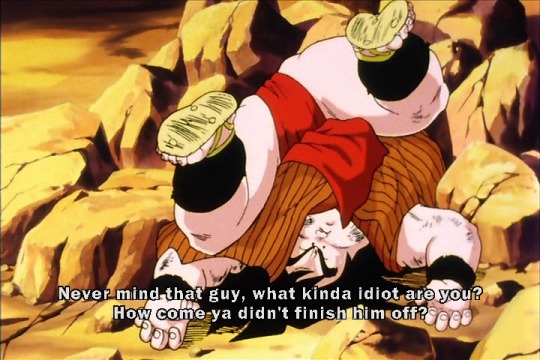
First off, we gotta wrap up the loose ends of the Saiyans arc. Krillin just let Vegeta leave the planet, because Goku asked really nicely. Yajirobe doesn’t understand that, so he calls Krillin an idiot. Why didn’t Yajirobe finish Vegeta off? He took him down with his sword, and then he stood there like a jerk and gloated instead of cutting off his head.
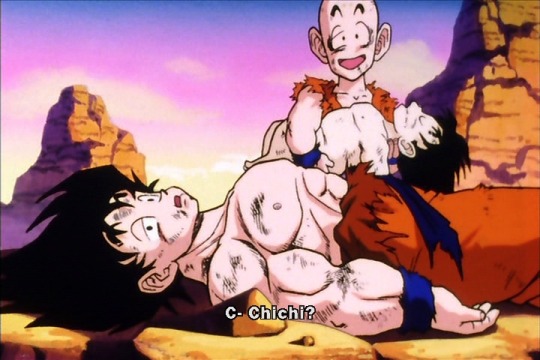
Krillin picks up naked baby Gohan and brings him over to half-naked ER patient Goku, but then an airship arrives, and out pops Chi-Chi.
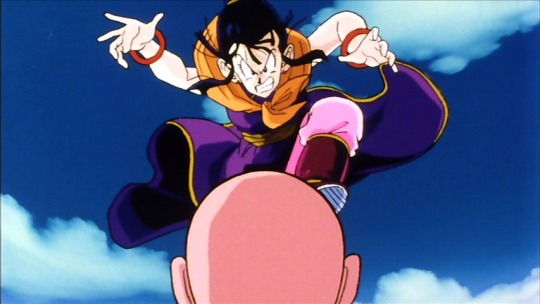
She leaps over Goku’s body and grabs Gohan out of Krillin’s arms.
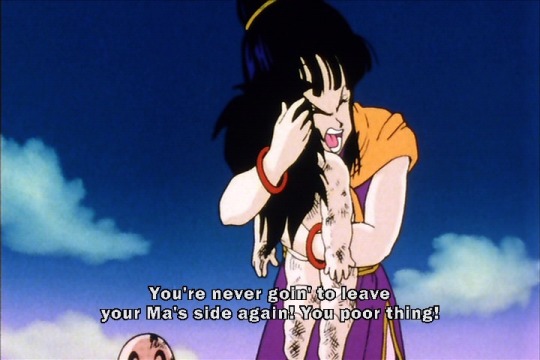
Fans give Chi-Chi a lot of crap for her behavior in this episode, and I’ll bet you a dollar that none of them have children of their own. Gohan’s five years old in this episode, and Chi-Chi hasn’t seen him since he was four. One day he just left and didn’t come back. Now she’s finally close enough to touch him and he’s all beat up and unconscious. What would you do?
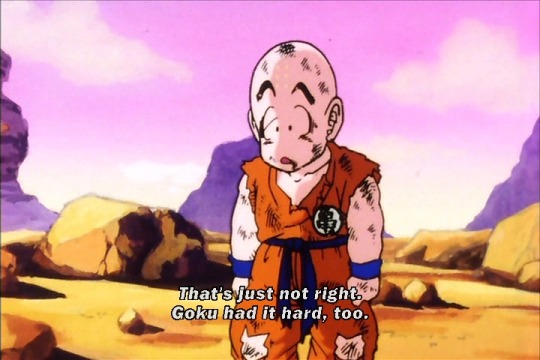
You know what? Goku did have it hard, but he’s a grown-ass man. He’s not entitled to Chi-Chi’s attention right now, but Gohan is. I think Goku knows that better than anyone in this episode, which is why you never see him complain about being ignored.
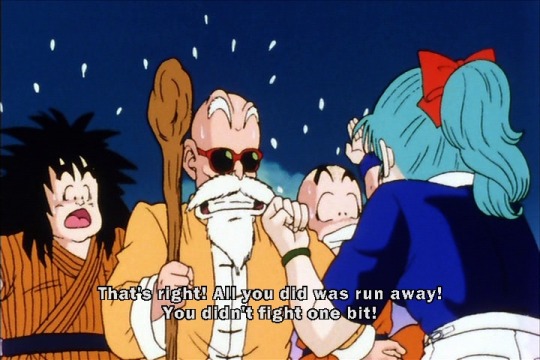
Bulma’s pretty upset about all of their dead friends, particularly Yamcha, because she used to be sweet on him, and particularly Kami and Piccolo, whose deaths mean that they can’t use the Dragon Balls to wish Yamcha back to life. She bawls out Yajirobe for not doing more during the fight. She’s got a point, although Yajirobe probably did more good by holding back and picking his spots. If Yamcha had shown the same level of caution, well...
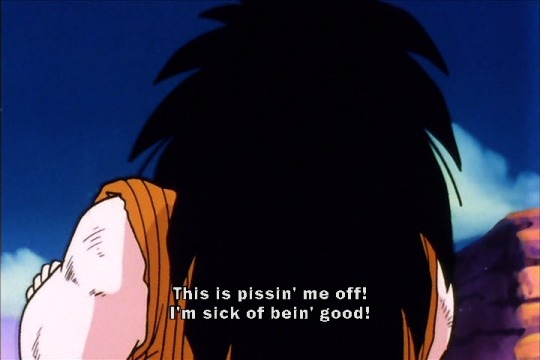
I sort of get Yajirobe’s attitude here. Everyone talks to him like he’s a piece of shit, and when he musters up the courage to be somewhat responsible, everyone still talks to him like he’s a piece of shit. And then they wonder why he doesn’t help out more often. He can’t win.

The gang loads Goku into the aircraft and then they head back to the first battlefield so they can collect the corpses of their friends. It’s a pretty somber ride, until Krillin finally explains his theory that they might be able to wish their friends back to life after all.
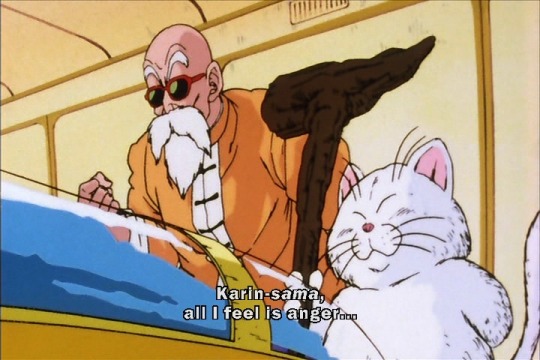

This is a pretty cool moment right here. There was a time when Master Roshi was happy to be surpassed by so many young and talented martial artists. Now, they’ve all been killed. Goku and Krillin were wished back, but the Dragon Balls no longer work, so that’s it. The next time Goku and Krillin die, they’ll be gone for good, and Vegeta’s up in space somewhere planning to make that happen very soon. But Master Roshi lives on, and he’s completely powerless to do anything about these new enemies.

For some reason, I forgot about all these scenes of Yamcha, Tien, and Piccolo being loaded into capsule coffins. Of course, the Ocean Dub never would have shown this part, because Saban had the script edited so that they were all blasted “into another dimension”. Showing their dead bodies would have undermined that already flimsy concept. Still, for some reason I remembered Krillin informing Roshi that they would find no remains for Chiaotzu, on account of him blowing himself up.
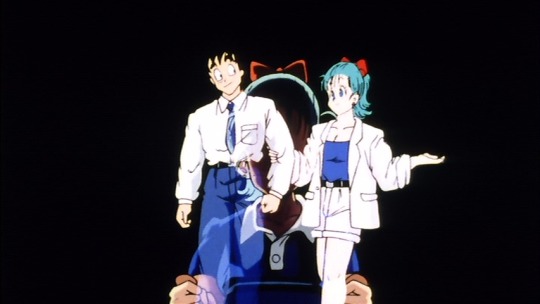
Bulma starts reminiscing about all the good times she had with Yamcha. That gets kind of awkward, because she spent most of their relationship being mad at him. This one flashback of them walking together never actually appeared before. Judging from Bulma’s Raditz-Era clothes, I’d say this would have been right before she got mad at him before they parted ways between Dragon Ball and DBZ.
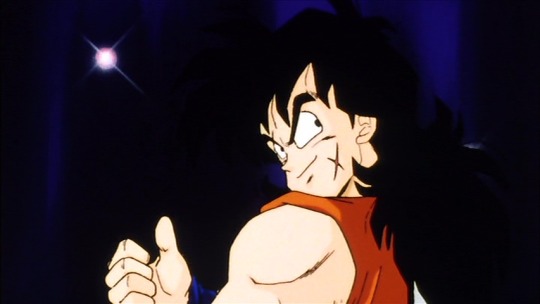
I prefer to remember Yamcha this way, standing proud on his own, rocking the Turtle Hermit dogi, got the long hair flowing down his back, giving the audience a low-key but heartfelt thumbs up. Vaya con Dios, Yamcha.
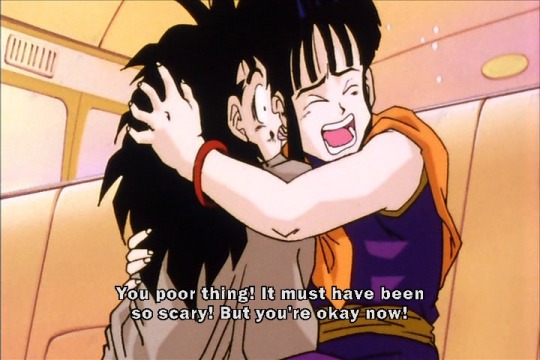
Gohan wakes up and Chi-Chi mothers him the way only a mother can.
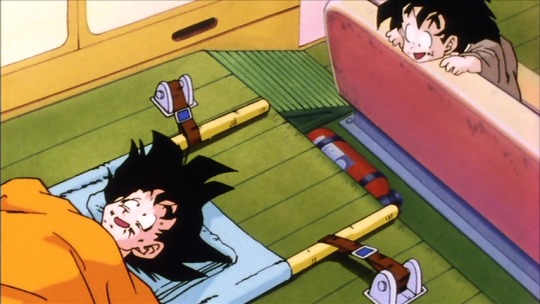
He looks in the back and finds his dad, badly hurt but still smiling. Look how happy the li’l guy is. It was a tough year, but he made it all the way through, and now he’s got his parents back.

Yajirobe tries to give Chi-Chi shit for ignoring her husband in favor of her son. First of all, fuck you, Yajirobe. Like you’ve got any business telling anyone how to act in public. You spend most of this episode picking your nose in the background while the others talk. Second of all, Chi-Chi knows her husband had the time of his life almost getting killed today. Gohan’s the one who needs her right now, whether anyone will admit that or not.
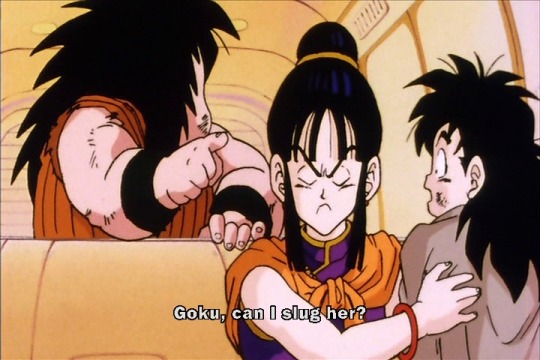
Yajirobe asks Goku if he can hit her. Yeah, go for it, Yajirobe. Make a move, I fucking dare you. I take back what I said before, Yajirobe sucks.

Anyway, Krillin lays out his big idea. When the Saiyans first saw Piccolo, they recognized him as a Namekian, an alien from the planet Namek, and Vegeta said that the Dragon Balls must have been a product of Namekian magic. During the battle, Vegeta abandoned the plan of using Earth’s Dragon Balls, in favor of simply going straight to Namek and finding more powerful Dragon Balls there. Krillin thinks he must have been on to something. If Piccolo and Kami were originally from Namek, then it stands to reason that there’s Dragon Balls there that still work. All they have to do is go there and find them, and they can wish their dead back to life.
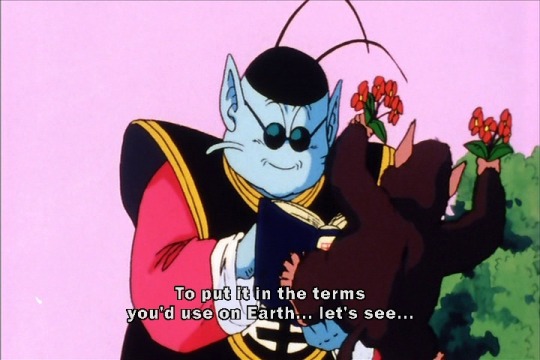
The problem is that no one even knows where the planet would be, but Goku contacts King Kai and asks him, and he knows all sorts of things about it. After praising Goku and the others for their efforts, he looks up its coordinates...
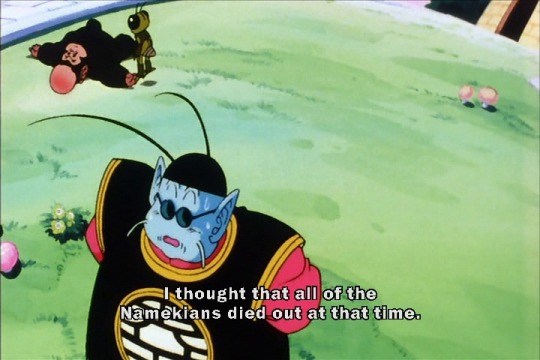
... and he gives some background on the planet’s recent history. He had believed that a natural disaster wiped out the entire population of Namek in the past...

... but he can sense fewer than 100 still living on the planet today, so the severe weather didn’t kill them all.

While they talk this all out, the gang begins to realize that the Namekian who split into Kami and Piccolo must have been a refugee, sent to Earth to escape the natural disaster on Planet Namek. For whatever reason, no one ever came to get him after the crisis abated. King Kai assures them that the Namekians are a gentle people, not like Piccolo at all.
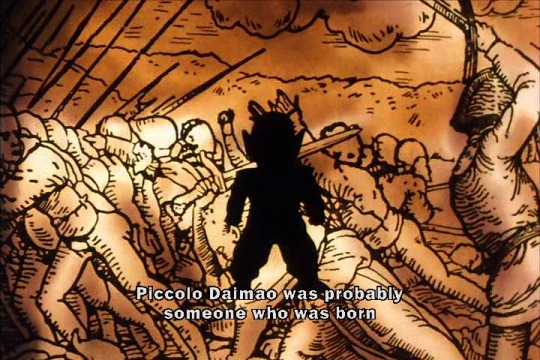
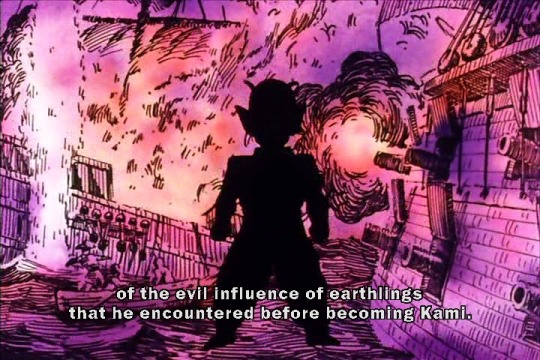
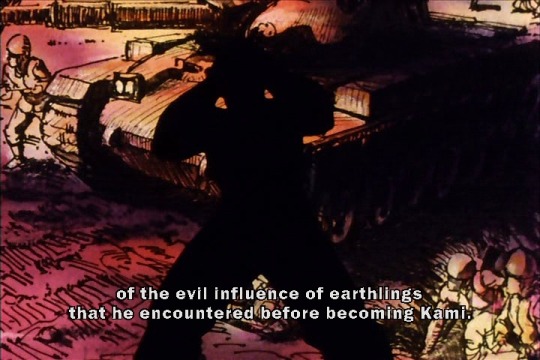
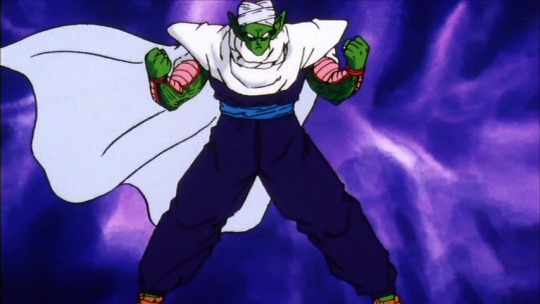
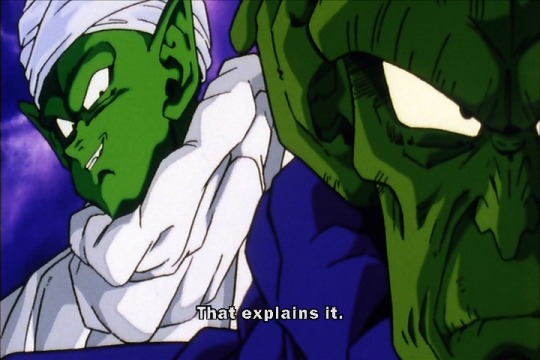
On the contrary, Piccolo’s evil was probably born from the corrupting influence of Earthlings, so who’s the real Demon King, I ask you?

While they all discuss this, Bulma crunches some numbers and determines that Namek is simply too distant to reach by spacecraft. The fastest ship Capsule Corp. has would take 4339.25 years to make the trip, and that’s just one way.
You know, I remember Bulma being pretty snotty about this in the Ocean Dub, almost like she was glad to burst everyone’s bubble. I can imagine an alternate universe where “4339 years and three months” would have become the big meme instead of “Over 9000.” Ah well.
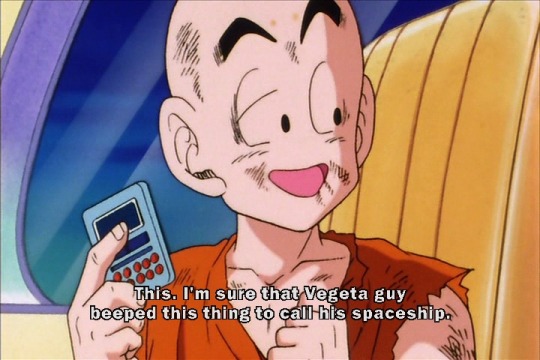
But Krillin’s got a solution in mind. He saw Vegeta leave in his spaceship, but it was clearly a one-seater. In the dub, he points out that there’d be no way that Nappa guy could have fit in there with him, so I just want to pass along that mental image. Anyway, the point is that Nappa must have come to Earth in his own ship, which must still be lying around somewhere. And Krillin stole Vegeta’s keyfob when he left, so he’s pretty sure they can use it to recover Nappa’s ship. From there, Bulma and her dad can reverse engineer the thing and it can make the trip in a much shorter time.

And now Bulma’s sold. I like that about her. A minute ago, it was impossible, not because Bulma’s a pessimist, but because she can only work with the technology available to her. Hand her an alien spaceship with a faster-than-light engine, and she completely changes her tune. She’s so scary good with gadgets that reverse-engineering alien tech is nothing to her.

Everyone laughs.
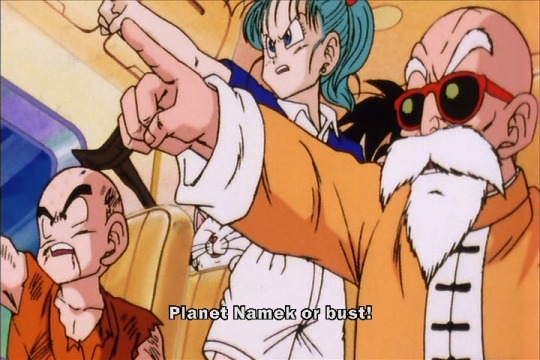
THEN THEY POINT.
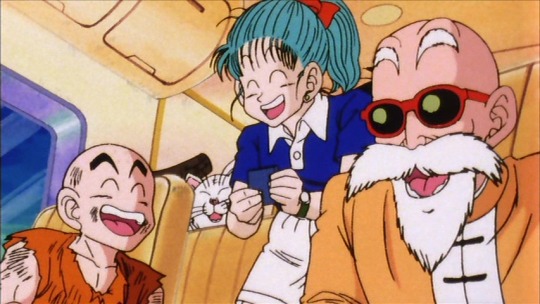
Then they laugh again.
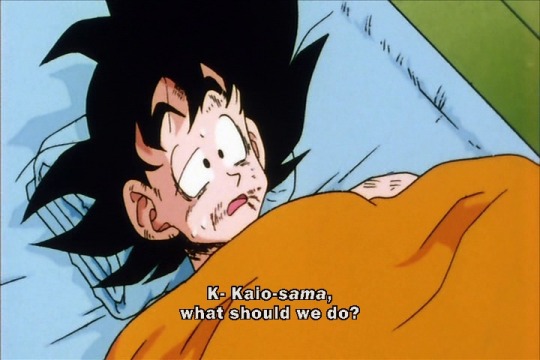
Goku tried to point too, but his arm has an owie.
#dragon ball#2019dbliveblog#goku#chi chi#gohan#krillin#master roshi#korin#yajirobe#yamcha#kami#piccolo#king kai#namek saga
43 notes
·
View notes
Text
Marvel Cinematic Universe: The Avengers (2012)
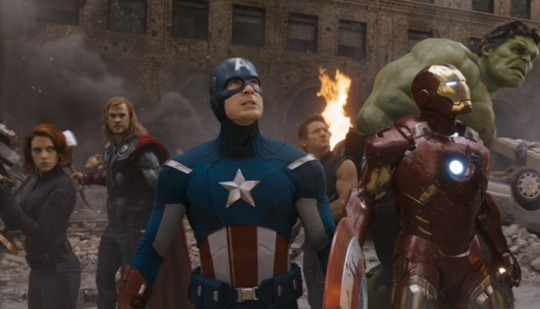
Does it pass the Bechdel Test?
No.
How many female characters (with names and lines) are there?
Three (23.07% of cast).
How many male characters (with names and lines) are there?
Ten.
Positive Content Rating:
Three.
General Episode Quality:
It’s solid. Unpopular opinion? I don’t think it’s half as good as people made it out to be, back when it first hit cinemas and everyone was swooning. It’s solid, but that’s the best I’ve got for it.
MORE INFO (and potential spoilers) UNDER THE CUT:
Passing the Bechdel:
...

Female characters:
Maria Hill.
Natasha Romanov.
Pepper Potts.
Male characters:
Nick Fury.
Phil Coulson.
Erik Selvig.
Clint Barton.
Loki.
Bruce Banner.
Steve Rogers.
Tony Stark.
JARVIS.
Thor.
OTHER NOTES:
‘free from freedom’ is such a wanky piece of writing, man. It’s absolute nonsense, but it sounds vaguely profound if you don’t think about it at all. I thought about it. It’s idiotic.
The very first thing we see of Black Widow in this movie is her being hit in the face, wearing a slinky little dress, tied to a chair being interrogated by a bunch of men. We’re supposed to indulge this excuse for hurting and objectifying a woman and then write it off as ‘empowering’ because she beats the Hell outta the dudes a couple of minutes later. That’s not a game I’m interested in playing. This is garbage.
The classical music over the beginnings of the Stuttgart attack is great.
All those German folks so confused by this Loki dude speaking English at them. What a tool.
I’m not sure I’ve ever heard ‘not today’ used as an effective badass declaration. It’s ALWAYS cheesy. Make it stop.
“There’s only one God, ma’am, and I’m pretty sure he doesn’t dress like that.” I don’t really like this line for Steve; he just doesn’t seem like the kind of guy who would play the ‘one true God’ card, and there was nothing in his origin story which implied that he’s particularly attached to religion at all; plus, he already read the brief on Thor, he knows this is literally the old Norse deity, there’s no question of whether or not they’re dealing with a God here. To argue the point (because he’s not MY God!) is meaningless in context, and feels like a weak attempt to correlate (Christian) faith with being ‘old-fashioned’, like OF COURSE Steve would defend the idea of the ‘one true God’, he’s from the past, not a cool enlightened atheist/agnostic modern man like the rest of us, right?
Thor and Loki are using such archaic phrasing, when Tony makes his ‘Shakespeare in the Park’ joke, it’s...more an observation than a quip. The Asgardians were not half as stuffy in Thor. It makes it seem like someone didn’t bother to see that movie first before writing their version of the characters.
Thor has to fight with the others when he shows up. He’s just gotta.
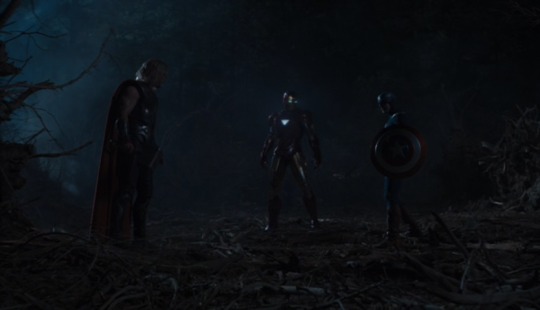
Gotta give a nod to Mark Ruffalo’s work here; I feel like I can see the clear comparison between his version of the character and Edward Norton’s in The Incredible Hulk, but at the same time there’s no sense of this being a Norton’s-Banner impression. Ruffalo is doing a sweet job of making the character his own without totally overhauling the template Norton laid down, and I dig it.
Oh, here we are. Loki calls Black Widow a ‘mewling quim’, which is just a fancy way of calling her a whiny cunt. Your gendered slur is still a gendered slur, movie.
I know they’re playing the idea that the sceptre is causing the antagonism between the characters, but fuck, it’s tedious. It just feels like they’re all contrived petty versions of themselves, being shitty because it’s ~dramatic~ for them to not get along.
I didn’t see this movie until months after it was released, and people were raving about how crushed they were by the major character death in the film but they were doing a pretty good job of not spoiling it; good enough that for a moment, I really thought I’d get to enjoy the surprise/horror for myself. You know who spoiled it for me? In a tweet, no less? It was the 44th President of the United States. Thanks, Obama.
This guy is the MVP of this film:
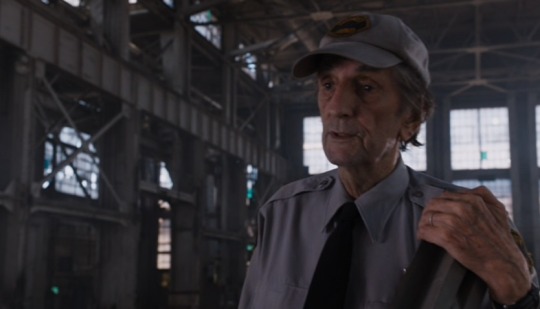
You can chalk “Son, just don’t,” up on the list of Things Steve Rogers Would Not Say. Just because he’s technically in his nineties doesn’t mean he isn’t still in his twenties in his mind: I don’t buy that he’d go for a blithely patriarchal term like ‘son’, it seems like another poorly-considered attempt to make him sound old-fashioned. Juxtapose that with ‘just don’t’, which is very modern vernacular. It might seem clever to combine the two as a meta-expression of Steve belonging to two different times now, but in practical application it just sounds out-of-character, and there’s nothing clever about that.
I know I said after the last movie that I love it when someone gets hit and flies off-screen in an exaggerated fashion, but Hulk punching Thor off-screen after they finish working together to take down the big beastie is an exception, because there’s no reason for Hulk to decide to hit Thor in the first place, it’s just a gag for the sake of a gag. I can’t believe they messed up such a simple pleasure.
I will forgive it, in return for Hulk smashing Loki all over the place. That was funny.
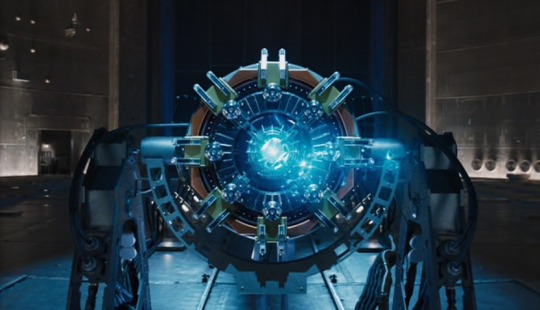
Back when this movie came out, before I saw it, I had people tell me - straight-faced, totally sincere - that it was one of the best movies they had ever seen. The internet was on fire with Avengers love. The film was rated in the IMDb Top 20. Admittedly, that all sets a pretty impossible standard for a movie to meet, and being at least a little disappointed in the result is probably a given. I was not particularly invested either way (I didn’t fall down the Marvel rabbit hole until later), so I didn’t allow myself to go in to my first viewing with such lofty expectations to be crushed, just the general assumption that this was gonna be good, it had to be good, at minimum. And it was that; it’s a good film. It’s entertaining. The plot makes basic essential sense. It’s easy to follow. There are some nice visuals, and most of the special effects are relatively clean, which can be a significant difficulty for big-budget extravaganzas that sometimes/often try to get way too much spectacle bang for their buck, so, a nice win. All in all, The Avengers is not a bad film. Sure is a bland one, though.
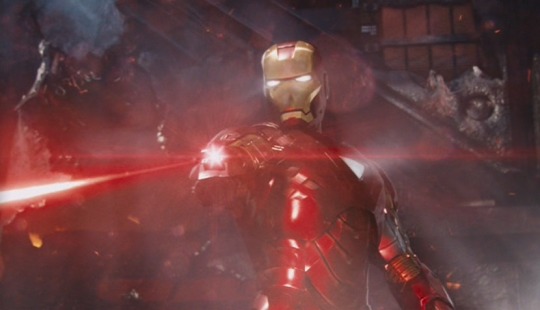
I know, I know, getting all these big-name characters from previous films together in one movie was a serious task and it’s hard to write a well-balanced script for so many leads, blah blah. Let’s put that whole equivocation to bed right now, because I honestly don’t think that balancing the big-name cast was the problem. All of the characters had something to do, no one felt like a random extra, I could quibble about certain places where I really wish things had been plumped up a bit (pretty much everywhere - the film is extremely low on meaningful character beats), but ultimately the characters are fairly evenly presented. What makes this movie bland to me is 1) the way that the personalities of the characters deviate from that established in their previous films, and 2) the simplicity of the story they inhabit.
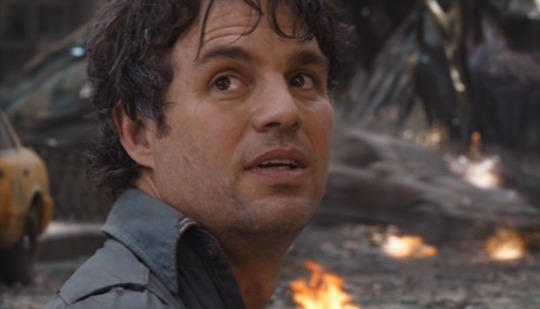
We’ll cover the Avengers themselves first: the good news is, Tony Stark is still Tony Stark. His personality is intact. Bruce Banner is, as noted, not exactly the Bruce Banner we met back in The Incredible Hulk, but that’s both a given and a good thing - the casting change is an improvement. Hawkeye was barely in the MCU previously, so we don’t really have enough to compare him against in order to make a judgment. Black Widow, however, is a bit of a mess; Joss Whedon’s special brand of misogyny is on display from moment one, as noted above (he LOVES writing women being brutalised because ‘how would we know/believe that they’re strong if we don’t get to see them overcoming mistreatment?’ - he tends not to feel the need to ‘prove’ his male characters’ strengths in this way), and Natasha’s personal story for the movie continues in a distinctly gendered vein: as is common for female characters being written by shitty dudes, her arc revolves predominantly around a man (Hawkeye), and she is ‘emotionally compromised’ by her attachment to him. She also zones out in the middle of an action scene and winds up in a corner shaking and traumatised (very out-of-character for a super spysassin), and particular emphasis is placed on all the bad things she’s done in the past and how she should feel bad about it, though no one does more than shrug their shoulders about Clint or Fury or any of the other SHIELD agents who are acknowledged as having dark and dirty pasts. Why is Natasha the one who is singled out to have her morality judged while her ‘arc’ focuses on her inconvenient emotional engagement? You know why. There’s no reason why this particular tack had to be taken in bringing her backstory into the film, and as a result of it we spend little time with Black Widow displaying the kind of cool professionalism and self-assurance she had in Iron Man 2. The inclusion of that vulnerability and backstory doesn’t make her feel more rounded or complicated because it is deconstructing the power and mastery of the character; rather than building upon the foundation set in her previous film visit, we’re questioning the stability of that foundation and seeing if we can get a few pieces of the structure to rattle loose.
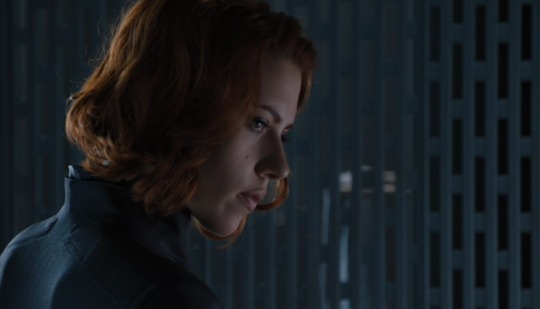
A big part of the trouble for Thor is that he gets saddled with that poxy Ye Olde Cliche dialogue, and there are few things worse for achieving character consistency than changing the way that they talk: no matter how hard the actor tries to play the character the same, they can’t compensate for the fact that the very structure of their sentences has been remodeled. They can improvise rephrasing the lines and/or argue the point if they want, but it’s hard to challenge every line, and if the director (who, oh look, is also the writer) insists you follow the script verbatim, there’s not a lot you can do with that. Poor Captain America suffers the same fate with the overt attempts to make him sound ‘old-fashioned’ by having him utter words and phrases that he never used in his origin movie. What’s worse is, this stilted dialogue is pretty much the sum total of the film’s acknowledgment of the fact that, oh yeah, Steve just recently woke up from the ice to find that seventy years has passed and nearly everyone and everything he used to know is gone. He has an exchange with Fury in his first scene, about ‘getting back in the world’, but there’s zero follow-up on how he’s handling it, what difficulties there might be, or even just how Steve is feeling about all of this on a basic emotional level. And yes, I am aware that there’s a deleted montage of Steve going about his day being isolated and out-of-touch, and it’s a travesty that they cut it because that’s essential character content, but it’s also a total bare minimum which has zero follow-up. Steve Rogers spends the whole film just being...there, speaking lines that don’t suit him or reflect the personality we just saw in The First Avenger, and not even in an understandable character-development ‘throwing myself into my work to hide from the pain’ kind of way. He’s kinda blandly self-righteous and all-business no-pleasure in exactly the way he was NOT in his origin movie; my impression is that Whedon doesn’t care for the character and wrote him off as the traditional patriotic cliche one might have expected him to be instead of the nuanced character that he actually is. As with Thor and Loki, it feels as if Whedon didn’t bother to watch the previous movies first in order to get a sense of the established characters.
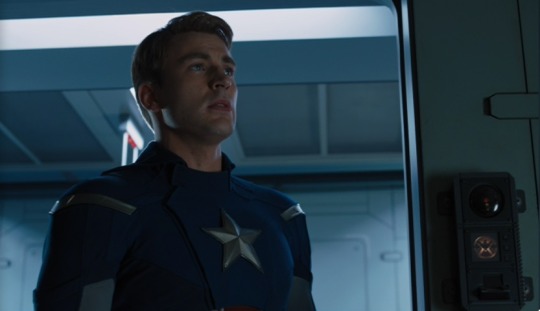
Speaking of Loki: if there’s one character who really, REALLY suffered a personality change in this script, it’s him. None of what made Loki the highlight of Thor is in evidence here; where that character was a cunning plotter full to overflowing with complex and contradictory feelings for his family and driven to action by that same emotional cascade, this Loki...wants to rule the Earth. Because. He’s, like, crazy, the other characters all say so, even Thor - the only one who actually knows Loki and is fit to assess his mental state - says that his ‘mind is far astray’ (what Thor thinks of that, whether he’s surprised or concerned, whether he feels like he understands why this has happened to Loki or not, is unclear, because, I dunno, Thor having feelings is as inconvenient to the story as Steve having feelings - as Loki snarls derisively about ‘sentiment’, we must remember that being emotionally compromised is dumb and only for women? Hmm). Loki is just a placeholder villain in this film, driven to action by nothing in particular, it’s just a business arrangement with a mysterious third party that coincidentally happens to involve Earth. Loki prattles and hollers a lot about how ruling is his right and people want to be ruled and blah despot blah, and it’s both supremely uninspired, and not true to the character we met in Thor at all - the Loki we know was not obsessed with ruling, his motivations were all about his family standing and the things he was denied within those relationships and their implications. I remember fandom, back when this movie came out, scrambling with various headcanons about Loki losing his mind in the void or being brainwashed, ad nauseum, because no one really seemed to feel like they were watching a logical progression of the same character at all.
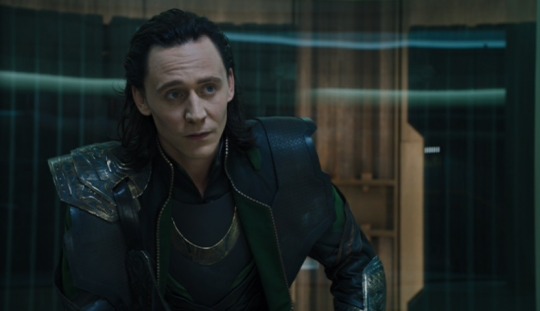
Now, one of the main ways that the lack of character consistency contributes to narrative blandness is that it disrupts narrative immersion - we’re re-negotiating the way that we engage with the characters, and that distracts from engaging with the story itself. At worst, we may even find ourselves cynical about every decision that a character makes (whether it’s in-character or not), because we’re too aware of the man behind the curtain to buy the act. There are definite shades of that in this film, but the worst of it comes from the whole team-antagonism schtick that is vaguely blamed on ‘Loki’s manipulations’ and the sceptre. The thing is, this all requires the characters to behave out-of-character, and since they mostly already are out-of-character due to bad writing, the exacerbation of that by creating artificial conflict feels like more bad writing, not actual plot. Having the characters initially get along poorly before triumphantly uniting to win the day is such an overused device, it’s easy to construe the conflict as arbitrary, and as it turns out...it is. Loki/the sceptre causing the Avengers to argue doesn’t actually impact the narrative in any meaningful way, since they don’t start a fight or fracture over it, it doesn’t slow down Tony’s efforts to learn what Fury is really up to, nor does it prevent Steve from investigating the same thing in person. Them conflicting with Fury and questioning their decision to work with SHIELD, etc, is a normal thing to have an argument about, no magic-mind-stick required; the only mileage the movie really gets out of the forced-conflict ploy is that Steve and Tony keep pissing on each other, which is extremely OOC for nice-guy Steve and WOULD throw up a big red flag for mental manipulations if the movie weren’t already misrepresenting him as an insufferable stick in the mud anyway, and even for Tony it feels off - he’s generally a jerk as a rule, but he doesn’t pick unprovoked fights - but again, when the movie is already so left-of-centre on so many characters everyone feels off, so it’s easy to assume the characters are just falling victim to contrived drama, and not something in the actual story. As noted, it doesn’t end up mattering where the conflict comes from anyway; the bad news is, it takes until the halfway point of the Goddamn movie before the characters get their prescribed ‘rough patch’ out of the way. The fact that they were just being really annoying for no real reason and without narrative consequence kinda steps on the idea of it being ‘triumphant’ when they all come together at the end to fight Loki, because there was zero reason for the audience to ever legitimately doubt that it would happen, not even in a begrudging-putting-this-genuine-disagreement-aside-so-that-we-can-save-the-world kind of way. It’s just dead air with no weight behind it, and with characters reduced to such cliche versions of themselves that it’s hard to muster the will to care.
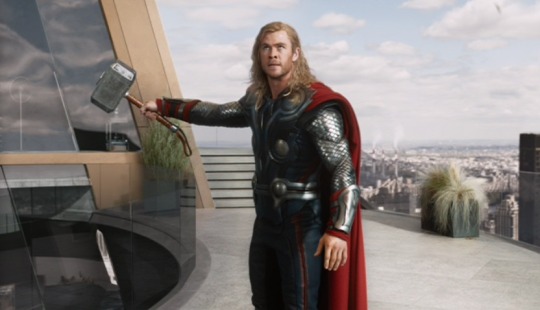
AND SO, we have a movie which, as previously noted, is awfully damn simplistic. That’s not a terrible thing, in and of itself - it’s all about what you do with an idea, and I would posit that a more complicated plot wouldn’t be a great idea here since there are so many primary moving parts in the form of characters to justify. But, the aforementioned griping about the skewy characterisation makes this film a bad candidate for character-over-plot, and if the shenanigans are falling flat, that’s when simplistic plotting becomes a problem. It goes like this: Loki shows up and steals the magic cube (action ensues). The avengers assemble to catch Loki (action ensues). The characters argue on a helicarrier until Loki’s goons show up to wreck shit (action ensues). Loki escapes and goes to New York to use the magic cube to portal an alien army to Earth. Action ensues until the portal is closed and Loki is defeated. The end. I’m not complaining about the action - it’s a standard facet of the genre, and most of it is entertaining enough (though the unnecessary Thor/Iron Man fight I coulda done without, and the battle of New York runs a bit long) - but the plot itself is pretty point-A-to-B-to-C without much in the way of surprises, and like I said, that’s fine so long as you’re delivering in another arena, i.e. STRONG CHARACTER NARRATIVES. And character is sooo far from being this film’s strong suit. The result? Is not very compelling.
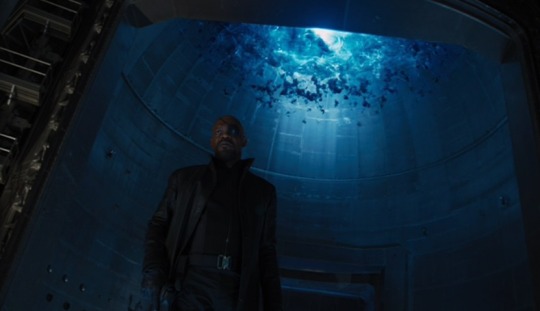
It tends to wind up that, by the time I get to the end of explaining why I think a thing didn’t work (and this is...the abridged version), it maybe seems ridiculous that I’m also saying ‘this thing isn’t that bad’. The truth is, there’s nothing that I think this movie does impressively well, and there are a lot of pretty major things that I think were poorly handled. BUT, I still meant what I said: it’s entertaining. It makes at least basic sense, and flows easily enough. And while I have serious issues with a lot of the characterisation and feel that - though balanced(ish) in handling - the plot failed to take real advantage of any of the character resources at its disposal (except maybe Tony), the actors still brought the goods to the table, and those whom I enjoyed in their previous films (I mean you, Chris Evans) didn’t disappoint, even though the material they were handling did. It’s a solid film, it’s good fun, I don’t regret watching it, and while I am irritated by various aspects, I don’t feel the need to keep ranting about them. And hey; Mark Ruffalo is really very wonderful. They’ve got that going for them.

20 notes
·
View notes
Photo
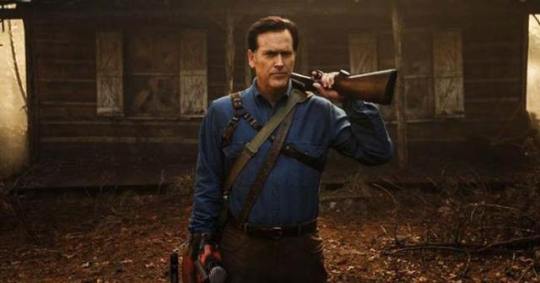
Interview with Ash vs. Evil Dead writer Bryan Edward Hill.
I wrote my first article on NAQB with pain in my heart. After spending years hoping for a fourth installment of Evil Dead, three years ago the announcement of the Ash vs Evil Dead pilot directed by Sam Raimi, (that Sam Raimi) and written by Sam, Ivan Raimi and Tom Spezialy… the same authors of the Evil Dead Trilogy was made.
After I watched the trailer with my closest friend we thanked God, hoping that it was not a farce, or a revival made only for money. Then we saw the pilot, in silence, with our eyes wide open. At the end of it, we looked at each other and we both thought the same thing: Evil Dead is back in the best way possible.
During that episode we got so excited by the absurdness of it, the intense thrilling sequences, the over the top humor and that pure horror that kept us glued to the screen since we were kids.
Raimi’s direction explains the Evil Dead world so well in a particular scene featuring the character of Amanda Fisher. She faces off against the demon who possesses the girl Ash had a one night stand with.
At one point, this creature gets up when her brain is decimated and looks Amanda in the eyes telling her, “We know who you are.”
After that point, the rules are clear: Deadites are not decaying Zombies, every deadite requires attention and details. Deadites are not the result of a virus.
When evil shows up again, Ash Williams tries to run away from it because he’s tired of facing it. His neighbor Vivian delivers a message to him when she is possessed, “It is time to test the mettle of man.”
Yeah… These three years were a test for Ash to prove his mettle. The Dictionary defines mettle as the “courage to carry on.” If someone wants to “test your mettle,” they want to see if you have the heart to follow through when the going gets tough.
It is no coincidence that The Mettle of man is also the title of the last episode of Ash Vs Evil Dead.
Ash vs Evil Dead has been canceled. What leaves me bitter about this turn of events is the fact that this series was created to make the fans happy. Now, these same fans have also contributed to the end of the series.
The Mettle of Ash, The Mettle of Bruce Campbell, a man who in order to please his fans, decided to take the risk of revisiting his iconic character 30 plus years later.
If I meet Bruce Campbell one day, I hope I never mention anything about Ash’s universe, I’d rather go in the woods to talk about nature than to mention Evil Dead to him. As a fan, I feel guilty about asking him anything about Sam Raimi and the Necronomicon, because in the end he gave us what we wanted and we failed to respond in kind.
The following is an interview conducted a couple of days before the announcement of the cancellation of the series.
The interviewee is Bryan Edward Hill, screenwriter of the episode Rifting Apart, the eighth episode of the series directed by Mark Beesley (the director of 2×07: Delusion).
I consider this episode to be one of the best in the series, so I decided to contact Bryan on Twitter who was kind enough to answer my questions. There are no questions about the cancellation.
This interview was made in collaboration with Emanuele Crivello of Evil Dead Italia (I will never stop thanking him for the last three years we spent talking about this series and doing everything we could to get it renewed. Also, thank you to the #bringbackboomstick movement designed by Susan Leighton) and the comics portal Lo Spazio Bianco (which dedicated an article to Bryan Hill and his career in the world of comics) and you can read the second part on the blog at the end of the interview.
NAQB: We interviewed the Meza Brothers, and we have discovered that they are hardcore fans of Evil Dead. How much and how did you know the Evil Dead franchise before starting to work on this episode?
Bryan E. Hill: Quite a bit, actually. When I was a kid, EVIL DEAD was that hard to find, completely insane horror movie that only the local, family-owned video store had. Watching it felt like I was watching something that was impossible. It had so much energy and creativity. Instantly, I was a fan of the franchise. I even wore a blue shirt for a little while. Had to be like Ash.
NAQB: AVED has always had a respectable soundtrack, was the music chosen during the script writing process or later in production? And how were The Drifters, MC5s and AC / DCs chosen for Rifting Apart?
Bryan E. Hill: That’s all show-runner Mark Verheiden. He’s got great taste in music, and he knew what he wanted to highlight the moments in that story.
NAQB: The scene in which Pablo fights in the hardware store alone gave me a shiver down my spine making me think of the S-mart Ending of Army of Darkness. Is it possible to read a piece of the script, with your comment?
Bryan E. Hill: I’d love to, but we have to keep the scripts under wraps. I will say that part of the fun with ASH vs EVIL DEAD is figuring out how to slay deadites in the coolest ways. It’s impossible to go into a store with a paint shaker and not think about putting a deadite’s head in it. At least it is for me, hahaha.
NAQB: Rifting Apart is one of the very few episodes in which Ash’s chainsaw does not appear … and it works so well! Is it important not to repeat too much in writing an episode of the series?
Bryan E. Hill: In general, you don’t want the audience too far ahead of you. You want to do new things and sometimes that means not using all the old things, all the time. Ash is such a great character that he doesn’t need a weapon to make a story work. With this episode, we wanted to dig a little deeper into his character and show the heroism he has underneath all that personality. Bruce did such a great job in those moments. He’s incredible.
NAQB: Seeing the complete episode on screen, what is your favorite scene in Rifting Apart?
Bryan E. Hill: I’m a fan of Kelly. Dana is just an awesome person so seeing her refusing to buckle to the evil in the rift was a joy.
NAQB: And what is your favorite episode of Ash Vs Evil Dead?
Bryan E. Hill: Mine! Ha ha ha. Not too proud to say it.
NAQB: Working with Ivan Raimi must be exciting. How was the script of the episode written? And what are the indications provided to you in order to work?
Bryan E. Hill: Ivan created a LOT of the work that inspired me as a kid. Having him in the room was an amazing experience. For everything we were doing, he would tell us what was “Evil Dead” and what may have missed the mark. Having him there was invaluable. He’s just a humble, brilliant and great guy.
--
PART 2:
Between the writing of the episode and the actual realization, how many changes have occurred? Can you tell us some behind the scenes?
Not too many, and all of the changes made the episode better. In television, the show-runner guides everything after the other writers finish their scripts and Mark did the great work of refining every script, making them as effective as possible.
What changes between writing a comics story and writing an episode of a TV series that involves many more people in the making?
Any time you adapt a written work you have to make changes, just to fit the format of live action. Every choice you see in a film or a television show represents the work of at least 100 people, all trying to make it the best thing possible. You try to keep the spirit of the original work, but you have to adapt it to fit the new format.
You have very respectable career, which were the authors who made you understand that in life you wanted to become a screenwriter?
George Lucas and STAR WARS were huge influences on me. As far as straight authors go, I was inspired to be a writer from reading Hemingway. There’s an honest in his work that struck me like lightening.
Which educational path must we follow to become a screenwriter? Is it enough just the school or do you have to do something outside the box?
Well, in addition to studying English, History and those disciplines, you need to read and re-read screenplays. Analyze them and learn from their execution. For me, the work of Joseph Campbell and Stephen King helped form my approach to storytelling.
Where does a good idea for a subject come from?
It can come from anywhere. Dreams. Moments in life. Anything. The key is to follow that inspiration when it hits. If you think there’s a story inside of something, there likely is.
I read the first volumes of Postal. I was really impressed by the protagonist Mark with his Asperger syndrome and his “Everything it’s in the right place” (I can not stop thinking about the song of Radiohead every time that sentence is pronounced). In Italy there are many positive reviews of the volume (published in Italy by Panini Comics). How was working on the plot and what are the satisfactions that came with this publication?
That was really challenging because it’s a story about people, not superheroes. It pushed me to consider people from different perspectives and experiences and learn to write them with authenticity.
I also know that it was bought for a TV adaptation! (We also write a news of it months ago) Can you give us some updates (if you can)?
Nothing yet, but if people follow me on twitter @bryanedwardhill you’ll get updates as soon as I can share them!
If you had not been a screenwriter, what would you have done with your life now?
Batman. I would have been Batman.
What are your future projects? Where do we have to wait? TV or comics?
Currently I’m writing TITANS for DCTV, my DETECTIVE COMICS story starts with the first issue in June. I’m writing MICHAEL CRAY for DC as well, and a few other projects that I can’t announce at the moment. Should have a feature film announcement soon. Follow me on social media!
8 notes
·
View notes
Text
Sexual Harassment In Nollywood: Fact or Fiction?
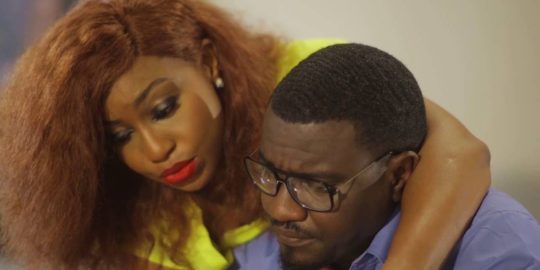
SEUN MANUEL FALEYE
“A renowned actor gave her an appointment to see him, so he could help her persuade her boss, another actor whom she was having an issue with at the time.” Yoruba actress, Bimbo Oni began, narrating to eelive.ng the sad experience of her colleague in the hands of a libidinous senior actor in Nollywood.
“The discussion got suspiciously longer than normal, which elongated her stay in his hotel room. After the discussion, the actor, locked the door and started to touch her in places that made her uncomfortable. She tried to leave, but he began to manhandle her. To the extent that he tore her dress. They struggled to the extent that she became weak and passed out. That was her saving grace. By the time she was revived, the sexual urge in the actor had disappeared, fear had taken over and he could only thank his stars that he did not have a dead body on his hands. My friend’s boss heard about the issue, but it was handled as a ‘we-we affair’, so the perpetrator was not arrested, nor was justice served.” Oni concluded.
Although, most of the actors and actresses who spoke to eelive.ng, said that they have not had personal experiences of sexual molestation in the course of their careers, they were unanimous in their agreement that there are many such cases in the industry. They have mostly credited their knowledge of the misdemeanor to third party testimonials; usually from their colleagues who were victims. Investigations by eelive.ng revealed that a substantial number of practitioners do not see it as anything more than an ordinary workplace hazard, something they need to grow the stamina to cope with.
Those who have been victims of the hydra headed pandemic at certain points in their careers stomach their experiences, accepting it as dues they had to pay or a requisite sacrifice for stardom, in the hands of their hot to trot and perpetually horny film marketers, producers and directors, who have been glorified to demi-gods in the industry.
Sexual Molestation As Old As Sin
On a broader spectrum, sexual assault has plagued our society from the early days. The menace is as old a sin – as the inception of the co-existence of man. Every profession, without an exception is confronted with sexual harassment. In academics, male lecturers put female students on the brink, and demand sex for marks, a requisite for them to graduate. Business executives demand sex from sales reps. and marketers to close business deals. Managers demand for sex in exchange for employments, certification and competence of applicants regardless. Even the sacred places of worship are not left out of the misdemeanor.
This much was buttressed by Actress and Blogger, Hannah Ogundare, she agreed that; “Sexual harassment is everywhere. It is not just in the movie industry. The reason why it is mostly heard of in entertainment, especially movie industry is because, practitioners are in the public eyes. The reason why we don’t really hear about such cases in other industries is because they are not they are the ones on television and radio, and they don’t make headline news in the print media.” she asserted.

The Situation in Nollywood
Regardless of this widespread nature of sexual molestation however, there is a worrisome permissive and liberal tradition that makes the act more prevalent within the film industry. Fast rising actress Oyinyechi Amos told of her experience as follows:
“I should have gone very far in my acting career, if not because of this so called sexual molestation. In 2014 when I first came into this industry, by my friend who introduced me. She introduced me to one director, they usually call him, Uncle J, he used to direct epic films for African Magic Epic. I usually played few waka pass roles in some of his films then. And he was also teaching me how to be a continuity manager too. But one day, he messed up. He called me, that he has a job to direct for someone and he wanted me to go with him to the location in Ogun State. And we would be there for two weeks. I packed my bags and told my mum where I was going. My mum had his number, they had spoken on a few occasions. So she freely allowed me. I was 21 years old then. I met Uncle J in his house at Apapa, then we drove in his car to Ogun State.”
On arrival, Amos explained that they drove to some hotel where the director said they were going to lodge and wait for the Production Manager for the film they were going to shoot to come for them in the morning. She was however shocked to see that the said Uncle J planned for them to sleep in the same room.
“We checked into same room. I told him, I have not slept in the same room with a man before, and I was not comfortable with it. He said I was behaving like I am not matured. He took off his clothes, trousers and pant in my front and walked naked into the bathroom. My heart was beating so fast. I didn’t know what to do or say.”
She informed eelive.ng that when she asked him to give her the script they came to work on; he dismissed the request and asked her to leave work until the next morning. Done with his bath, he allegedly came back into the room, ordered food for two from the kitchen and then settled down to sleep.
And this is where Amos’s story gets very sordid as she told our reporter:
“After we ate and it was time to sleep, he started his moves, touching me all over and that night, he had sex with me multiple times. I didn’t struggle with him, I just cried, but he didn’t mind. As soon as I saw day light the next morning, I left the hotel with my things before he woke up. Until today, I have not set my eyes on him again. I told my mother what happened when I got home, because, I don’t hide anything from her. My mother called him and laid curses on him. Since then, my mother forbids me from chasing my acting career. It’s just now, that I am gradually coming back. I think I can handle things better now, and acting is really my passion.”
In her own case, actress Bisola Omoniyi shared as follows:
I went for an audition and I was picked, after the casting, the producer asked me out but I refused due to that I wasn’t called for the shoot. There was another shoot I went for and during the process of the shoot, the director single handedly picked that he will like to have me in his bed but I clearly stated that ‘ko le werk’ because of that, he started frustrating me on the set . But of course I finished the job despite the frustrations and bid him good bye.”
Celebrated film director, Tope Oshin , who started her career as an actor equally testified about the existence of the practice in the industry when she told the BBC World Service as follows in an interview: “I have practiced in Nollywood now for about 20 years, I started as an actor. I was more aware of it (Sexual Harassment) as an actor, because it seemed more as an unspoken culture. There were instances where producers would say to me, I have a role that is perfect for you, if you could only come see me at so so hotel, the role could be yours. “I had instances where I turned such offers. But there were people who took those ‘opportunities’, they saw it as a step forward in their careers, and truly it did pushed them forward.”

Various Dimensions
Eelive.ng findings showed that sexual assaults in the industry take a variety of dimensions. Sources tell us that there are a few senior female producers who unduly woo their younger colleagues in exchange for roles, there are the pimps who set their peers and younger colleagues up for men who wishes to have them at a fee, there are the male marketers, directors and producers who offer roles for sex to up and coming actresses, a practice that is also otherwise known as “couch casting”.
A Yoruba actress who wanted to be anonymous shared her experience with a senior female practitioner; “A female producer once invited me for her production. She was the friend of the boss that trained me in the industry. You know in Yoruba movie scene, we usually have bosses. I trained in Ogun State. So I have always begged the aunty to invite me for her production whenever she wanted to shoot. So she invited me for the production too. After the shoot, she begged me not to go home yet, that I can play with her in her home. So we went to her house on the outskirts of Lagos together. I just noticed she’s fond playing with my breasts at the slightest joke. Or hit my ass. The major surprise was when she said we should go and bathe together. I didn’t even count it. I just told her to go first. After all that she brought out Hennessey from her refrigerator, she made me comfortable, we talked like mates, even though she was much older than me. I got very high that evening. Next thing I knew was she started to touch my private part. I was still in my bra and panties because we were alone, and I didn’t think anything like that could happen. Although, I was drunk and too weak and put up some feeble resistance and at the end of the day, she left me alone. Eventually, I saw her bringing out her vibrator and satisfied herself. None of us said anything about it. I just acted matured about it, but I can never make the mistake of being in the same room with her again.”
Adenike Ayodele shared her experience with a director who assured her of a leading role in his soon-to-be shot TV series.
“A particular Director wanted something else and began to promise me some big roles in a particular TV series. Maybe he was thinking I was a greenhorn. After all was said by him and he noticed I didn’t oblige him. He decided to give the role he promised me to someone else. Till date, he avoids me like a plague and he keeps saying I offended him by behaving like a child. It really doesn’t matter as long as my integrity is intact.”
Yet, People Are Mum
Those who spoke to eelive.ng indicated that most of the cases of sexual harassment in Nollywood are, like in other industries swept under the carpet. They identified reasons ranging from desperation of girls not to ruin their chances of getting more opportunities, ignorance as to the relevant criminal laws against forceful sex as well as the fear of stigmatization. “This is more so, as history has shown that most people accused of rape do not just commensurate punishment at the end of the day, so why ridicule yourself unnecessarily,” an artiste asked
Once speaking with this writer, award-winning actress, Genny Uzoma said in reaction to questions about what her she would do if she ever faced sexual assault in the industry that: “I’ll probably not speak up. I’ll deal with it my own way by refusing the person’s advances and moving on except if it’s rape. I hate being the center of attention in controversial cases though it can’t be helped sometimes.
She said further:“Truth is, anyone speaking up on sexual harassment faces a lot of things – scorn, disbelief, and even detestation by her fellow women, who would be like ‘it happened to us, it’s the norm, why are you screaming blue murder?’ She might even be unofficially blackballed and blacklisted in the industry. You must be very brave and strong to speak up on issues like this. I’m strong but I’ll save that strength for other issues. All those ladies in Hollywood coming out to accuse Harvey Weinstein kept it secret for years for one reason or the other, till one person summoned up courage because she felt she had nothing to lose.
Corroborating the position that offenders either get away with this crime or just punishments that are nothing more than a mere knock on the head, human rights lawyer, Evans Ufeli, recently informed that despite the overwhelming cases of sexual assaults in Nigeria, only 18 rape convictions have been recorded in the country’s history. Nollywood practitioners therefore reason that if the entire country has such a poor record of convictions, how could the film industry be different!
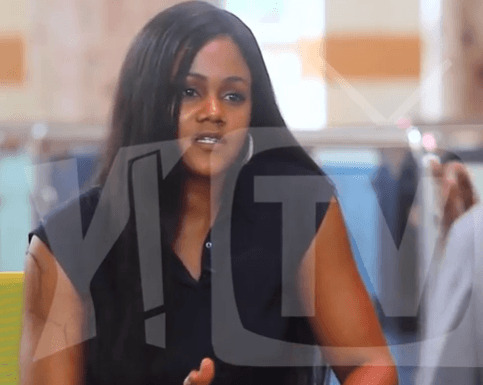
Those Who Have Spoken Up
In the wake of recent allegations by Busola, wife of Gospel Soul Singer, Timi Dakolo that Abuja based Preacher Biodun Fatoyinbo of Common Wealth Zion Assembly had illegal carnal knowledge of her about two decades back, some Nollywood actresses have raised similar allegations.
One of such actresses is Kemi Afolabi who accused a Yoruba filmmaker, Laide Olabanji of alleged sexual molestation while she was yet to find her footing in the industry. And just as she voiced out the allegation, three other actors, Wunmi Toriola, Funmi Awelewa and Hannah Ogundare all claimed to have had similar experiences with the same person.
Olabanji however denied these claims in an interview with eelive.ng insisting that these ladies whom he brought into the industry only aimed at tarnishing his over three decades experience in the history.
He explained: “I met Kemi Afolabi through Mercy Aigbe in the Gbagada area of Lagos. She had shown interest in acting, and I offered to give her a role in my movie. We usually assemble somewhere before proceeding to location to next day, usually for rehearsals and production meeting. It is like a suite. So that faithful day, we were in the sitting room of the suit, I was guiding Kemi for the role, and held her, to demonstrate an action. She then asked why I was holding her in that manner. That was it. I told her she needed to be flexible to be an actor, actors are not rigid. The following morning she left for Ebute Metta with the pretext to be going to move her wardrobe and costumes for the shoot we wanted to do. And that was how she left. Until date, almost 20 years later I have not set my eyes on her. Earlier this week, the association called us to mediate between us, she said she saw me in 2017 at AMVCA but I didn’t see her….”
Speaking about Wunmi Toriola, Olabanji said: “everyone knows her character. She has even fought Toyin Aimakhu that brought her into the industry from Ilorin. She once hit something on the head of a girl that was her personal assistant during one of my movie shoots and constituted a nuisance on the set. Since then, I decided not to invite her for my productions again. I have a name to protect. I can’t allow young girls, who just came into the industry to spoil it for me.” He clarified.
The pattern usually is for these directors or producers to invite actresses to come read for roles or audition for roles at hotels, or their homes. And mostly, these invitations come with stern instructions for these actresses to come alone. Sadly, the naïve once sad fall for the gimmick.
In 2015, cross-over actor, Rahama Sadau took to Instagram to accuse Adam Zango of denying her of a role because she refused his sexual advances. She, however, apologized the next day, describing her post on a matter as sensitive as sexual harassment, as ‘childish.’
A young female actor turned producer who does not want to be mentioned confessed that she had to compromise in a few ways before she made an inroad into the industry and would in fact love not to let her daughter grow up in Nigeria given the deep patriarchal sentiments in the country.
She explained: I would really wish my daughter grow up out of Nigeria, the male dominance psyche makes it natural to victimize women. I can’t wish for my girl child to experience what I experienced surviving. Although I’m not proud of some of the things I have done trying to survive. First as an actor, now as a producer. It is tough, but what can we do? I have had to shamefully bend my back, compromise on my values to survive.”

When Actress Lay The Bait
Investigations by eelive.ng however show that there are situation when actresses are either complicit or even initiators of the sexual relationship with some of the men in the position to influence their careers.
As a matter of fact, men who make passes at ladies themselves go after soft targets such as greenhorns and mediocre, without the requisite talent that can stand them out. A source told us that ���these men go after those who show traits of desperation and naivety and are probably not been to any film school to learn acting formally. These ones are usually seen as having nothing to offer apart from their beautiful faces, and their bodies.
Buttressing his point that actress who know their onions and are confident about themselves would hardly find themselves in this situation, our source referred to recent interview Tana Adelana had with London based DJ Abass on his programme, “For the Record”. Asked if she knew ‘couch casting’ in Nollywood, she replied saying she wouldn’t know because they have not come to her and vowed to expose anyone who makes such unholy passes at her.
In further support of this position, Actress Hadiza Abubakar recently released a video where she took a swipe at her colleagues whom she accused of willingly offering their bodies to producers and directors, sometimes even production managers. She noted that most of these actresses already gave themselves cheaply for a slot on the screen and should not have the guts to call out any producer or director,
A production manager, who simply asked to be called Okechukwu agreed with Hadiza that some fast-rising actresses rely on people like him to lobby directors for roles for them and that such people were usually ready to do anything.
Okechukwu said; “There are a lot of ‘I want to act’ girls out there. Once they know you are into production, they start to ‘chewing gum’ you. Usually, I quickly chop and clean mouth, before taking them to film locations, because, once they get to location, and directors and producers start to like them, they will forget us the PM, that once helped them, unless she is your normal girlfriend!”
Another source revealed that: “90% of the time, it’s the women offering the men sex for roles in the Yoruba movie industry,” she informed further that most marketers and producers accept this “free sex” without scruples! The question is can this also be referred as harassment?

When Male Actors Try Their Luck
There is another existing although rather uncommon situation wherein male actors sexually harassing female producers and directors. Director, Tope Oshin recounted her experience during an audition exercise in the BBC interview quoted earlier: “I’ve had a situation where I was casting director and an actor walked to the front of the camera, introduced himself and said, ‘lovely hair’. I said thank you. He went on, ‘My name is so so so, I’m an actor, but I have other hobbies that could interest you. I replied, what are these other hobbies? He responded; ‘any way you want me to please you ma’am.’ It took all of me to keep a straight face, then I told him, we would only be needing your acting skills today. The he said, ‘Okay, but it’s still open ma’am, anytime you want me.’ I had to tell him, can we see your performance, we don’t have all day. This has necessitated my stance as at auditions, which makes me wear plain looking face, no emotions. I just go straight to the point, I don’t crack a smile. I ask for your name, and straight to what you have to offer,” she posited.
The Repercussion
A veteran filmmaker, once told this writer in confidence that these assaults and unabated sexual character displayed by Nollywood practitioners was a one of the factors responsible for actors lack of show of commitments to marriages.
“As a people, it is important we understand that rape experience leaves it’s victims with a lot of damage. Apart from increasing their chances of contacting sexually transmitted infections, it also causes mental and emotional imbalances. Rape is causes low self-esteem too.
“One wonders why a lot of our actors and actresses cannot stay in a committed relationship for a long time without break-up and divorce. These are some of the after effects that these victims suffer but cannot speak of, for fear of being misunderstood.” He explained instructively.
Read the full article
0 notes
Text
A Year in Filmmaker Interviews: From Patty Jenkins to Paul Thomas Anderson
New Post has been published on http://gossip.network/a-year-in-filmmaker-interviews-from-patty-jenkins-to-paul-thomas-anderson/
A Year in Filmmaker Interviews: From Patty Jenkins to Paul Thomas Anderson
At the beginning of 2017, I set out on a mission to interview the directors behind some of the year’s biggest movies. In total, I was fortunate enough to speak with 22 of them. They are the filmmakers behind blockbusters and conversation starters, and they represent one particular slice of what the movie landscape in 2017 looked like from behind the camera.
Here they are (you can read or watch each interview by clicking on the film title):
M. Night Shyamalan, Split
Digging into the 2017 archives: Here’s part of my chat w/ M. Night Shyamalan for #Split where I asked whether being known as the guy w/ the “twist endings” has helped or hindered his career. pic.twitter.com/ssG0S125cs
— ErikDavis (@ErikDavis) December 19, 2017
James Mangold, Logan
Jordan Vogt-Roberts, Kong: Skull Island
Gareth Edwards, Rogue One: A Star Wars Story*
James Gunn, Guardians of the Galaxy Vol. 2
Ridley Scott, Alien: Covenant
Jon Watts, Spider-Man: Homecoming
Alex Kurtzman, The Mummy
Patty Jenkins, Wonder Woman
Colin Trevorrow, The Book of Henry
Michael Bay, Transformers: The Last Knight
Matt Reeves, War for the Planet of the Apes
Christopher Nolan, Dunkirk
Darren Aronofsky, mother!
Doug Liman, American Made
George Clooney, Suburbicon
WATCH: Earlier this year I spoke to George Clooney & Julianne Moore about #Suburbicon and what it’s like directing a Coen brothers script pic.twitter.com/HzBrjr8vFW
— ErikDavis (@ErikDavis) July 27, 2017
Jason Hall, Thank You for Your Service
Taika Waititi, Thor: Ragnarok
Kenneth Branagh, Murder on the Orient Express
Guillermo del Toro, The Shape of Water
Paul Thomas Anderson, Phantom Thread
Rian Johnson, Star Wars: The Last Jedi
At #D23Expo, I asked @rianjohnson how he’d compare #TheLastJedi to the other #StarWars movies. Here’s what he said… pic.twitter.com/2cVDfBbVD2
— ErikDavis (@ErikDavis) July 18, 2017
*Technically, this film hit theaters in 2016, but the conversation around the movie continued well into the New Year, so it makes the list!
All of these conversations were engaging and insightful, and you can read what came out of them at the links above. Do I wish I spoke to more women filmmakers? Of course I do. And do I wish more women filmmakers were afforded the chance to direct some of the year’s most important movies? You’re damn right I do. Hopefully 2018 will produce more opportunity for female filmmakers, and I will make it a personal goal of mine to tell more of their stories in the new year.
That being said, of the 22 filmmaker interviews I conducted in 2017, there were ten conversations that stood out most. Check out a little more on those below.
10. Matt Reeves for War for the Planet of the Apes
One of the questions I asked most often when speaking with filmmakers this year was for them to discuss some of the other movies that influenced them during the process of making their movie. When it came time to discuss the excellent War for the Planet of the Apes with Matt Reeves, he and I pretty much spent the entirety of our conversation talking about that film’s many influences, so much so that I created a separate piece listing the titles, as well as how they inspired the third Apes movie.
From Apocalypse Now to the Empire Strikes Back, this was an enjoyably nerdy convo about some great movies. Here is Reeves on how Empire influenced Apes:
“For me, I was very excited about this idea about the mythology of the Force and what it meant, and I thought, “Wow, there’s something really powerful about what that represents in these stories, how it’s this representation of dark and light,” and for me, it was like a light bulb,” he said. “[Cowriter] Mark [Bomback] and I started talking about it, that actually we’d had that all along, because our Force was this question of human nature, this idea of looking at us grappling with the different aspects of our nature… you know the animal and the rational.”
9. Ridley Scott for Alien: Covenant
Ridley Scott doesn’t care about spoilers.
When I sat down with him, Katherine Waterston and Danny McBride to chat about Alien: Covenant, Scott was so open about the film that Waterston had to keep interjecting in order to stop the director from not only spoiling its biggest secrets, but also his plan for future Alien movies.
It was probably the most amusing of all the filmmaker conversations I had this year, with Scott not afraid to say whatever was on his mind, both to me and about me. When I mentioned how much I liked the different ways he used blood on a floor to escalate tension in a scene, he called me a “sick f**k” and we all had a good laugh.
Needless to say, I’d happily have another chat with the sassy Mr. Scott (curse words and all!), who began our convo with these words about Alien: Covenant:
“It’s beginning to answer the who and why,” he said. “It’s definitely gorier, and smarter. In it, we raise some very interesting questions about the position and possibility of AI against human condition, and it crosses into the zone of apartheid — kind of like how Roy Batty was treated like a second-class citizen [in Blade Runner]. And so is David (Michael Fassbender). The knee-jerk was to create a second-class citizen, even if he is superior to everyone. So the natural thing to do at the end of Prometheus was to send them off together because when you think you’ve got it, you’ve got to keep the characters alive, as opposed to killing them. And [Coventant] starts to answer the who and why.”
8. James Mangold for Logan
James Mangold was proud when we spoke. Proud of the movie he had delivered, and proud of the risks he and the cast took to produce a dark, gritty and violent superhero movie unlike any that had come before it.
What I enjoyed most about this interview was Mangold’s honesty. We spoke openly about the state of superhero movies and what they need in order to continue evolving. For Mangold, the success of future comic-based films isn’t necessarily about ratings or risks or audience fatigue.
“I believe there was a time in the middle ‘50s where people were like enough with the Westerns, I’ve seen enough Westerns,” he said. “There was Gunsmoke and Bonanza on television, and nothing but John Wayne, Clint Eastwood in theaters. I’m sure people saw way more bad Westerns than they did good ones. But now, 30 years later, we look back and the good Westerns live and the bad Westerns are out of distribution. I imagine the same thing will happen with comic book movies, where in 30 years when we look back it’ll be the movies that touched us that live. It’ll be the movies with heart that live.”
7. Taika Waititi for Thor: Ragnarok
There’s a reason why Thor: Ragnarok topped my list of favorite movies of the year (see below), and much of that has to do with its director, Taika Waititi.
This is Waititi’s biggest film to date, and it’s one that accomplishes so much. Not only does it tonally reboot Marvel’s Thor character utilizing the series’ existing cast, but it also leans into humor so much that the film acts as a borderline genre parody at times. Like Rian Johnson’s Star Wars movie, both films use comedy to lighten up a broader message to fans, which is: stop taking this stuff so seriously!
With Thor: Ragnarok, Waititi proved that you could be super silly and kick lots of ass, and the two aren’t mutually exclusive. It may be Marvel’s most watchable movie to date (I’ve watched it six times!), and it’ll no doubt push Waititi’s career behind the camera forward in a major way.
But when he first began discussing the film with Marvel, even Waititi was a little confused about why they were talking to him, exactly.
“I was only apprehensive because I thought, I wonder if there is some other filmmaker with a name that sounds like mine who they think I am,” he joked. “Because, you know, coming from what I’ve done, I was like man, this is odd. I definitely agree with a lot of the fans who’ve given me sh*t on Twitter and in that I’m not the most obvious choice. I feel like I’m a very unexpected choice, here. But, then obviously, you look at James Gunn and the Russos. You look at what they’ve done, coming into the MCU. It’s not very surprising, that they would ask me to do this.
6. Jordan Vogt-Roberts for Kong: Skull Island
I love speaking to filmmakers on the verge of releasing their biggest film to date, and such was the case with Jordan Vogt-Roberts, who I met back when he was debuting a film called The Kings of Summer at the 2013 Sundance Film Festival. Vogt-Roberts is an outspoken dude who says what’s on his mind, and he brought that creative confidence to his first major studio movie, Kong: Skull Island. He pitched them an idea that was unlike the one they were already working on, and he set out to make sure his vision — and not someone else’s — was the one audiences finally saw on screen. And when I finally caught up with him a couple of days before advance tickets went on sale here at Fandango, Vogt-Roberts was thrilled that all the nerdy things he had wanted for this film had materialized in a big way.
“I wanted this crazy genre mash-up, and I pitched them this idea of Apocalypse Now meets King Kong,” he said. The original script had nothing to do with that, and the original script almost in no way reflects the movie that’s on-screen. The fact that the studio let me run with these really crazy ideas and let me build out this sort of wish fulfillment, most insane version of this movie is cool. This is the movie I’d want to see and the movie I think my friends would want to see, and hopefully audiences feel like it’s something they haven’t seen.”
5. James Gunn for Guardians of the Galaxy Vol. 2
A few of the interviews that I conducted this year were timed to when advance tickets were going on sale. What’s unique about that time period is it’s often weeks before release and the films typically aren’t finished yet. Such was the case when I spoke to James Gunn, who took my call from inside the editing booth while he worked feverishly to put the finishing touches on his Guardians of the Galaxy sequel.
Gunn was playful, loose and confident – and of all the directors I spoke to, he came off as the biggest, dorkiest fan of the characters and world he had helped create. When I asked about major Easter eggs, he giggled, turned to his editor and confirmed there was a big one only a few frames into the film. Not all filmmakers are as excited to work on a big, important sequel like Guardians Vol. 2, especially when the first Guardians was unexpected and came with way less pressure on its shoulders. But Gunn is a rarity; he is someone with immense love and adoration for the property and it spills out of him organically and with passion. When we spoke, all I heard on the other end of the phone was this guy who simply couldn’t wait to share his baby with the world.
“I think the whole movie is going to surprise you,” he said. “It’s something you don’t normally get in big spectacle films. There’s a ton of heart to it, and then the visuals just go above and beyond anything we’ve ever done with the Guardians or at Marvel Studios. People thought we took a lot of risks and did a lot of new things with Guardians Vol.1, and we sort of exponentially upped that in Guardians Vol. 2. It is nothing like anything that’s come before it.”
4. Michael Bay for Transformers: The Last Knight
Personally, I’m not the biggest fan of Michael Bay’s Transformers movies — I will fully admit that. They’re big, loud, complicated and I never know which robot is which. But I have always admired Bay’s work ethic and just how far he goes to deliver a big-screen experience like none other. Bay quite literally gives it his all, and is the farthest from someone who’s just phoning it in for that blockbuster paycheck. This is a dude who hustles for every shot and for every explosion. He is part of a select few working hard to push the theatrical experience forward.
Bay’s first three movies – Bad Boys, The Rock and Armegeddon – are three of my favorite action movies ever, and so when I had the opportunity to speak to the director for almost 30 minutes, I leapt at the chance to not only talk about his tenure as director of the Transformers series, but also his work ethic, his stunts and, yes, those first three movies.
Because the interview was a long one, I decided to break it out into three parts (Michael Bay: Past, Present, Future), and my favorite of the three parts was looking back at Bay’s first three movies and how they forever changed him as a filmmaker.
On Bad Boys: “It literally was such a hard experience,” Bay said. “The crew kept telling me, ‘Well that’s not gonna cut, and that’s not gonna cut,’ and ‘You can’t do it like this.’ And I’m like, ‘Well, I’m doing it like this.’ So it was one of the first movies where it was cut very fast, the action. They all said, ‘You can’t cut that fast.’ I’m like, ‘Well, I am.’ And now you see it imitated, but way back when I was cutting fast for a reason … to hide the cheap art direction and to give it some energy.”
Read the entire interview here: Past, Present, Future
3. Christopher Nolan for Dunkirk
Christopher Nolan is an intimidating interview. Not because he’s mean or dismissive – quite the contrary. Nolan is a very nice guy and happy to dissect his process, but he’s also precise and no-nonsense, and knows exactly what he does and doesn’t want to talk about. (When I tried to slip in a Batman question, he quickly shot back: “I’m here to talk about Dunkirk.”)
I spoke to him twice this year – once at CinemaCon in Las Vegas roughly four months prior to the release of Dunkirk, and then again right before release and after I had seen the movie. The more memorable conversation was the one in-person at CinemaCon. I had ten minutes with him right before he was to introduce a big presentation to exhibitors. If he was nervous, you couldn’t tell. I was definitely more nervous – this was my first time interviewing the filmmaker, and I wanted to get the most out of those ten minutes.
So we spoke about Nolan’s love of IMAX and just how different Dunkirk was to anything he had done before. Like Michael Bay, Nolan is a filmmaker who cares deeply about the cinematic experience, and with each movie he sets out to push boundaries and put cameras in places they logically should not be in (like an IMAX camera on the wing of a plane). And as we spoke, I could tell this was a very personal film for Nolan. The story of Dunkirk was one he learned of when he was a little boy. He grew up around it; the events at Dunkirk were a part of him and when he set out to put the story on screen, he did so in the most authentic way possible, going so far as to shoot on the beach at Dunkirk. I noticed him light up when I mentioned the aerial sequences, though. This, I think, is what Nolan was most proud of when it comes to filming Dunkirk.
“I don’t think anyone’s ever tried to do aerial combat the way we’ve done it and photographed it in this film,” he said. “My DP, Hoyte Van Hoytema, just never gave up. When we would look at how you can’t fit a camera in the cockpit and fly the plane, we would build a special kind of snorkel lens and put the camera there. We’d work with the pilot and plane owners to really just go for it, and do as much of it for real as possible.”
Read the entire interview here: Part 1 and Part 2
2. Patty Jenkins for Wonder Woman
When I spoke to Patty Jenkins for Wonder Woman, she was fired up. The first couple of screenings for the film had produced excellent reactions, and I could sense a tide turning from within the studio, from hesitant and skeptical to confident and joyful. Wonder Woman was still weeks away from becoming the biggest hit of the summer and one of the year’s most talked-about movies, but with a dynamic, energized Jenkins in command of its story, there was a feeling the film was going to be a much bigger deal than initially anticipated.
Jenkins and I spoke at length about the year’s only female-driven superhero movie, but it was the director’s story behind the “No Man’s Land” sequence that stood out most. It was clear after one viewing that this scene would define the movie, but no one knew at the time just how big of an impact this moment would have on the entire year in pop culture. It is arguably the best scene in a movie this year, and it is a scene that almost didn’t happen.
“It’s my favorite scene in the movie and it’s the most important scene in the movie,” Jenkins said. “It’s also the scene that made the least sense to other people going in, which is why it’s a wonderful victory for me. I think that in superhero movies, they fight other people, they fight villains. So when I started to really hunker in on the significance of No Man’s Land, there were a couple people who were deeply confused, wondering, like, ‘Well, what is she going to do? How many bullets can she fight?’ And I kept saying, ‘It’s not about that. This is a different scene than that. This is a scene about her becoming Wonder Woman.’”
Read the entire interview here, here and here.
1. Paul Thomas Anderson for Phantom Thread
Of course I have a bucket list full of filmmakers I’d love to interview at some point during my lifetime, and Paul Thomas Anderson (Boogie Nights, Magnolia, Punch-Drunk Love, There Will Be Blood) has long been situated towards the top of said list. I had tried to interview the elusive writer-director for three films now, and with his newest, Phantom Thread, arriving this Christmas, I finally slipped past the PTA gatekeepers and found myself tossed into a vibrant, personable 20-minute conversation with a filmmaker I have long adored.
We sat in a hotel room inside the Four Seasons in Beverly Hills, and for twenty minutes we spoke about Phantom Thread, about working with Daniel Day-Lewis, about the movies that changed him and influenced him, and, somewhat randomly, about Star Wars. The chat concluded with us musing about the various Nutcracker performances both sets of our kids happened to be participating in over that weekend, and I left wanting the conversation to continue, naturally (there were a million questions I still wanted to ask), but also with this immense feeling of satisfaction, as if I had finally conquered a mountain that had eluded me all my life.
My favorite part of the interview came when I asked PTA which of his films he learned the most from in terms of the filmmaker he wanted to become. Here’s what he said:
“I felt like on Punch-Drunk Love it was a really nice moment. We had all worked together — almost all of us – on three films before that [and] that really turned out good. We learned loads on that. But by the time we got to that film, there was something that kind of clicked; of experimentation and independence and confidence. Guts, care, and hubris all just kind of came together in a nice way, allowing ourselves to discover things, or be insecure. It was a really nice moment, but it was also f**king challenging. The first couple weeks of that film was just trying to find a new way to work that was a little bit looser. Yeah, I look back really fondly on that time with a great feeling. A lot of lessons were learned on Punch-Drunk Love.
Read the entire interview here, here and here.
Finally, to finish out the year, here are my 15 favorite movies of 2017. Wanna know more about these picks? Hit me up on Twitter right here.
youtube
1. Thor: Ragnarok
2. The Big Sick
3. Three Billboards Outside Ebbing, Missouri
4. Get Out
5. Star Wars: The Last Jedi
6. Foxtrot
7. Logan
8. I, Tonya
9. Good Time
10. War for the Planet of the Apes
11. The Florida Project
12. Baby Driver
13. Dunkirk
14. Call Me By Your Name
15. The Shape of Water
Thanks for reading, and here’s to 2018!
Source link
0 notes
Text
ART OF THE CUT with Michael Berenbaum
Michael Berenbaum, ACE won two Emmys and two Eddies for Best editing for Desperate Housewives and Sex and the City. His work also includes editing both Sex and the City movies, and other TV series including The Wire, Nurse Jackie, The Americans and Marco Polo. Art of the Cut interviewed Berenbaum before he spoke at the Manhatten Edit Workshop’s Sight, Sound and Story post-production event.
HULLFISH: You cut a bunch of feature films and you cut a lot of television. What is going on in television right now? Are you just as happy as an editor cutting TV as you are a feature film?
BERENBAUM: I’m just happy editing anything really. People ask, “What’s the difference between cutting a feature and a TV show?” It’s really not the way I approach the project or editing the scenes per se, it’s more about the politics of who you’re working with and for. On a feature your allegiance is to the director. You and he or she go through the entire process locked in a room together. Obviously, you have to deal with the producers and studio but your director is your cohort throughout. On a TV show, the directors don’t really have the power that they do on a feature. They come and shoot. They work with you for a few days and then they’re gone and you work with the producer to lock the shows and mix them. Usually, the producer is the show runner or one of the main writers. The studios and the network are involved but you work more with the showrunner than the director.
HULLFISH: That’s a tricky political situation, right? Because though your real alliance or allegiance is to the producer/showrunner there still has to be a temporary allegiance to the director because you are trying to achieve his vision, but you’re also the steward for the way the show goes together and you know how it’s supposed to work.
BERENBAUM: That’s exactly right. And a lot of times the director doesn’t. They’ll be in the cutting room and say. “Oh, let’s cut that line out. That seems a little draggy.” And I’ll say, “That is kind of the most important line in the show,” knowing what’s coming up in the next few episodes. In his director’s cut I will obviously do whatever he wants to do, knowing that two days later that line will come back once the producer sees the cut. Directors will watch previous episodes but they’re not really 100 percent in tune with what’s going on with the show.
HULLFISH: Do the politics or the different deadlines affect your approach to cutting the scene, between features and TV?
BERENBAUM: For me, personally, I’d say “no.” Every editor has their own way of working and when you work in television you have to learn to work very quickly. I find that when I go back to doing a feature it’s so luxurious: to have the time to experiment and try different things and screen them for people. You don’t get to do that on TV. The audience doesn’t see it until it is on the air, meaning there are no previews. Just the producers, maybe the writers and the network get to see it. They’re your audience and they’re the people who provide feedback. It’s just a much quicker process.
HULLFISH: So with your fast approach to the scene on a feature, where you do have that luxury, are you still working as fast with the same methodology? You just have more chance to experiment? Or do you slow down and take more time with dailies or spending more time on a specific cut?
BERENBAUM: I have to really, consciously think to slow down. I know that I will have plenty of time to do what I need to do. I set my own pace. I know where I need to be at any given point. I know the schedule. I know where I need to be by a certain date. So if I have a really big scene I know I can watch the dailies… ingest them… think about them… maybe put that scene aside and let it gel in my mind before I actually jump into it. And I’ll go back and do some shorter scenes that I know I can knock out pretty quickly. Then one day I’ll just be inspired to jump into that big scene. Get into the zone and just zoom through it. When you’re finished with production (principal photography) on a feature there’s a period of maybe a week or two after the last day of dailies before you’re going to show the film to the director. That is two weeks on a feature versus maybe two days on a TV show. You still want to get through the dailies and have a chance to put it together… watch it a couple times yourself, put some temp music in, some sound effects and just get it to an air-able state before you even show it to the director. That’s what the job has become; to get almost to a locked fine-tuned product before anyone sees it.
On a feature after you show it to the director you have 10 weeks to just work with the director and go through every scene again. On a TV show, for a half hour show, maybe you’re only with the director for two days, or four days for an hour show. It’s really up to that particular director how involved he wants to be. Sometimes I have directors come and sit with me for two or four days and sometimes they’ll just watch the show and send me an email with some notes or even just chat on the phone.
HULLFISH: I have a very similar approach as you with the bigger scenes where I feel like I need to sleep on them.
BERENBAUM: Exactly!
HULLFISH: Your brain needs to subconsciously work on that scene so you pick some easier scenes to do today. And then wait a day or more on that other scene. What is your approach? How have your assistant set up your dailies and what do you do?
BERENBAUM: My assistant sets up each scene in an individual bin. Multiple camera takes are grouped together. They’re sorted from first set up through A-B-C – however many setups there are. Then what I usually do is watch one take from each set up. If it’s multiple camera I’ll watch it in a split screen. Just to familiarize myself with what they actually shot; what angles I have to work with.
The hardest thing is deciding where to start. Unless there’s a big dolly shot that is obviously the opening of the scene, the hardest thing is to know where to begin. Knowing that things will probably change before anyone sees this, I just pick a shot to start with and then go through every take for the next line in the scene. What angle will be next? What’s the best performance for the next line? Without watching all the takes all the way through, I’ll just work my way through them line by line as I’m putting something together. Just try and get a cut together as quickly as possible, section by section line by line and then I watch it and I’ll see what is working and what isn’t and I make my adjustments to make it flow as best as possible.
HULLFISH: It doesn’t sound like you use selects reels.
BERENBAUM: I don’t. I know a lot of editors use stringouts; where they’ll have an assistant piece together each line of the scene in one long sequence so you can look at each take for each line by screening this one string out. Sometimes it becomes useful once the director is in the room. You can look at options very quickly. I tend to work so fast that by the time the assistant has assembled the stringout, I’ve already cut the scene and moved on. So I don’t use them very often personally, but if I have a scene where there is a lot of coverage, I’ll have my assistant break the shots down into subclips or stringouts just to make it easier to organize.
HULLFISH: I do talk to people that watch ALL the dailies before cutting anything. That could easily be 90 minutes for an entire scene. I find that when I try to do that I can’t remember what I’ve seen. I can’t wrap my head around 90 minutes of footage.
BERENBAUM: That’s exactly my take. I am not a good note taker. I agree with you. You have all this coverage – multiple readings of one particular line – and you hear them over and over again as you’re watching through all the dailies. I find it difficult to make choices as I’m watching the whole scene. So line by line and take by take I make my choices as I build my scene. So ultimately by the end of cutting that scene I will have viewed all of the dailies.
HULLFISH: I have a really granular question about that because I’m interested in your technique. I think I’m working a little slower than you might be doing and so I have two different ideas. I have a KEM roll where it’s all of the dailies in order one after another from action to to to cut or even beyond that. Then I break it down – not necessarily line for line but kind of in groups. It depends on blocking, for example, if somebody is in a room and they cross then I’ll say, “When they’re sitting on the couch over here just cut every take and setup for that section. And then when they cross over and sit at the table, let’s make that another section.” That way you can wrap your head around 20 seconds of the scene at a time. But it does require the time for me or the assistant to break that down. But it’s also awesome for when the director comes and he wants an alternate reading of a line.
BERENBAUM: That’s something that can be very useful. Also, ScriptSync can be a valuable tool when you’re going to be sitting in a room with the director for 10 weeks.
HULLFISH: Have you used that before or is that not a tool you like to work with?
BERENBAUM: Occasionally.
HULLFISH: In your personal method, because of the speed that you’re trying to work, are you leaving marks as you progress through each take? On the source do you leave the timeline where it is? You mark an in so you know, “I’ve covered this part of the script” because otherwise on every single line and every single take you’d be trying to find the next line.
BERENBAUM: That’s correct. So I’ll mark an in and an out. My fingers are just kind of trained as it’s playing to hit in and out for that particular section. So that’s left up and I’ll rotate around through all of the other takes and when I get back to that take those in and out marks are still there. I’ll just go to the out mark and continue on from there. Sometimes I just can’t decide if there’s two or three takes that I really like and I put them all in my record monitor and just insert in each one into the prior shot and see how it flows and which one plays better with the shots around it then then eliminate the two or however many that aren’t working as well.
HULLFISH: How do you edit audio? Do you only use one audio track when you’re cutting your original rough? Or do you have an audio cut on a simple scene that’s seven or eight tracks deep of production audio?
BERENBAUM: I never work with just one track. On my current show (Divorce, for HBO) I have up to 16 tracks sometimes for each episode. For dialogue two or three tracks is all I usually use. I have a couple of tracks for stereo backgrounds and sound effects and a couple tracks for music. I usually use the mix track and I checkerboard. If a line or two happens to have been off-mic on the mix track. I’ll go back into the lavs.
HULLFISH: I’m interested in your bin view. Are you a Frame view guy?
BERENBAUM: Yeah. Frame view.
HULLFISH: So let’s talk a little bit about performance. It’s always something that interests me: not only the determination of best performance but why the editor needs to craft the performance. What situations might you – even with a great actor – need to help them?
BERENBAUM: Every actor – Good bad great – You always need to help along a little bit. There may be sections where they’re just on fire. And I tend in those cases to just let ‘em go. You don’t want to cut away. You don’t want to interfere. But even the greatest actors occasionally they’ll flub a line or repeat themselves and you want to keep the flow going. So you cut away to a reaction. Not arbitrarily but where reaction is needed. And under that reaction you can change takes, take out some air, make it flow. I mean that’s just the basics of editing.
HULLFISH: A lot of times – especially if the story has been shaped quite a bit in the editing room beyond what the script was – an actor might have a delivery where the context of it has been changed because of the edit, and then the editor needs to change what was a very good performance that now doesn’t work with the new storyline.
BERENBAUM: With some actors, they’re awesome on take one. Then they experiment to vary their performance but you know that their early takes are going to be their best. Other actors like to get into it and they’re just warming up on take one. So you have to go with the flow and adjust how you work depending on the actor and what the scene is.
HULLFISH: It can be tricky when you’ve got a scene where one actor is great on take one and the other one’s great on the last take, right?
BERENBAUM: When is that not the case? Yeah, that’s always what’s going on. What keeps it interesting is no matter how many times you’ve done it or how many projects you’ve worked on, every show is going to present its own set of challenges and problems to solve. And for me that’s what keeps me on my toes… Keeps me interested. There’s no phoning it in.
HULLFISH: With that in mind – how one actor is warming up while another is cooling off – how much faith do you put in the script notes of circle takes and best takes?
BERENBAUM: I’ll go out on a limb and say zero.
HULLFISH: That’s my take on it. I’m with you on this but it’s kind of dangerous to say, right?
BERENBAUM: Exactly. You don’t want people to know that you rarely pay attention to what they’re writing down. Things that are hilarious on set aren’t always hilarious when you watch them in dallies or when they’re in the cut. You make best efforts to acknowledge what the director liked best on set. But God knows that’s not always what works best in the scene. So you can’t just rely on that.
HULLFISH: The director’s own take of which take is best is very different sitting in a screening room or sitting in the edit suite than when he’s sitting on set.
BERENBAUM: Exactly. It’s hard to say that’s the best take because if it’s a three-minute take, it might be great for the last line or the first line but you have the whole rest of the scene where maybe the other takes were better for that section. You really have to scroll through everything that was shot to verify what you have. Down the road when you’re trimming things down, compressing, you go back and find a complete and utter mistake where they re-blocked the scene. Things are completely different. That’s what saves you because you’ve changed it so much that what they thought didn’t work on set and they changed it is what will work exactly the best when you come to your final version of your scene. Or the actors will have overlapped and the director will say, “No. Take your time there.” And you find that the overlap was exactly what was needed there. That happens more often than you may think. Sometimes there’s a camera bump or something that just adds a little bit of anxiety or it just puts the audience a little off guard and it may not have been good on set, but it’s that little bump that maybe takes the scene to the next level.
HULLFISH: Can you think of the last thing you learned about editing?
BERENBAUM: You’re always learning. There’s infinite stuff to learn.
HULLFISH: Do you find yourself doing splits on two-shots or wide shots to change pacing of performances?
BERENBAUM: Yeah a lot. If it’s an over the shoulder or a wide shot: On an over the shoulder and I have the foreground person with their arm up in the air and when I cut back to them their arm’s down and it just looks weird, I will do split screen. Find a section where that character’s arm is down and be able to fix the continuity. On a wide shot, I might have a character or a couple characters sitting at a table and somebody on the left side Is looking the wrong way when I want to cut to them next. You can just do a picture-in-picture and find the section with that character looking the right way and put it in. Just yesterday I had a wide shot where I had a character walking down a big set of stairs and a couple frames before I wanted to make my cut the director or somebody walked in front of the camera on the left side of the screen. I was able to erase them by doing a split screen for that section.
HULLFISH: I think there are a lot of inexperienced editors that would say, “Oh well, when the director walks into the scene, that’s when I have to I’ll have to cut to something else.” But if you don’t feel that’s where you need to cut, based on the pacing, then you have to find a way around that.
BERENBAUM: “Finding your way around that” is the subtitle for an editor’s job. You’ll have a director come in and say, “Can we lose that line? And it’s in the middle of a oner. Or it’s in the middle of a person crossing to the other side of the room. How do you get rid of that line without completely messing up the blocking and the continuity? Well, you’ve got to find a way to make it work. That’s what the job is. Find your way around that.
HULLFISH: I’m naming my next book that. I’ll be sure to credit you. You mentioned handing stuff off to your assistant. Do you find yourself handing sound effects or music or….
BERENBAUM: I do hand over to my assistant for sound work and sometimes they take the initiative and put in music. It’s great to see the cuts after they do their pass. It makes it easier for me to see the pacing of the scene and what maybe isn’t working so well…What needs to be sped up. The sound just gives you so much more information as to where to be and where to go.
HULLFISH: The sound does affect pacing.
BERENBAUM: Absolutely. Stuff that seems as tight as it could possibly be before you put sound in, becomes “Oh, there’s an extra 12 frames in there to get rid of. What was I thinking?” That happens all the time. I also like to give my assistants the opportunity to cut scenes and then look at them together and give some pointers. Sometimes they do stuff that is great that I would never have thought of and I’ll use parts of it and other times I’ll say “Try this, try this, try this.”
HULLFISH: What are some of the things that you found that your assistants are doing wrong? ANY advice?
BERENBAUM: A jarring sense of flow. Cutting for continuity. Slow pacing.
HULLFISH: Now the big question here is – when you say cutting for continuity – do you mean that they don’t cut for continuity or they’re too drawn to cut to continuity.
BERENBAUM: I think that’s the biggest mistake any beginning editor makes. You’re waiting for something to match to go to your next shot and in doing so you’re killing the pace. Walter Murch has that list of priorities and continuity is the last one. That’s really true. I think part of my job is being a magician where the hand’s quicker than the eye. My job is to say, “Look over there!” while I have a bad match over here. You can get away with a tremendous amount of bad continuity if the scene is moving and the scene is flowing and you’re involved in what’s happening. The emotion of the scene.
I had to cut a scene with four actors standing outside all smoking cigarettes. You can imagine the disaster with every cut whether the cigarette is in their mouth or their hand is by their side. I got a note from the studio and the executive said, “Is there a way you can fix that one mismatch in that smoking scene?” And I said, “So you didn’t notice the other hundred mismatches? Great!”
HULLFISH: So that’s one thing you mentioned: not necessarily waiting for continuity, but to cut when you need to – when continuity is correct. What are some other mistakes?
BERENBAUM: Being in the wrong angle. You know certain shots are shot because they’re complementary to other angles. Sometimes the eyeline will be wrong – not that eyelines always have to be right. Those rules are meant to be broken but you have to hide the fact that that’s what you’re doing and to have the scene continue to flow and not be jarred by what’s happening. Holding too long. It’s usually a pacing thing.
HULLFISH: I’ve heard that from multiple people. Even if it was moving along, the rhythm of it didn’t feel natural. Those are hard things to learn but it does help to have someone like you explain the problem and then when you recut the scene you watch the previous version and the next version and then you can detect how the pacing changed and what the benefit was.
BERENBAUM: Exactly and sometimes after they cut it I’ll send them back to recut it. And sometimes I will just go on my own and we’ll do an A and B and compare. For me, it’s helpful to see what they’ve done because then I’m able to get a better jump on the scene before I’ve even gone through dailies. I see what the scene is and I can see pretty quickly where I want to be and where I don’t want to be when I do my version.
HULLFISH: The mistakes actually help you progress. You talked about the advice or correction that you give to your assistants but the flip side is that the director comes in and gives us notes about what he thinks we did right or wrong. How do you handle those notes?
BERENBAUM: That’s something that, personality-wise, you have to be able to handle or learn to be able to handle, because it’s never the final version. When you cut it – as much as you think you captured it and nailed it – you know you have a bunch of other people who will be weighing in. They’re going to have different insights into what they’re looking for or different opinions. You have to be willing to try 100 different things. It’s very easy to get defensive about what you’ve done and sometimes I’ll know there’s not a better version than this; and depending on who that person is that I’m working with I can say that, or I just will do what they want and try as many different things as they want. And sometimes a director – and every editor has had this experience – the director or somebody will come up with an idea and you just think that is the worst idea I’ve ever heard. But you keep that to yourself. You try what they want and usually it doesn’t work. But a lot of times it leads to a third option that neither of you had thought of and that ends up being the best option of all. So it never hurts to just mess around with stuff and you can’t be too precious about what you’ve done. It isn’t always based on how you cut the individual scene. It’s based on the cumulative effect of the project.
HULLFISH: And that’s another interesting idea: the idea of pacing not just shot to shot within a scene but also the pacing of the entire story from the opening credits the closing credits.
BERENBAUM: Ultimately that’s where the magic lies. Somebody may say, “It’s boring about halfway through the movie.” What does that mean? Part of the job of an editor is to be able to say, “OK, they think it’s being boring in the middle of the movie. Why is that? Maybe there’s something happening about. 15 or 20 percent into the movie that’s slowing down the pace that’s affecting the middle of the movie.” And if you fix that earlier scene, maybe now the middle is not so boring. It’s really a lot of analysis. I think I’ve learned over the years and I’ve become much better at being able to look at something and say what’s not working. Why is it not working? What is affecting a scene that people think is the problem when it’s not necessarily the problem?
HULLFISH: In other words: that the note is valid but it’s not necessarily at the right point. Well, Michael, this has been very enlightening. Thank you for your time today.
BERENBAUM: Appreciate it. Thank you. Bye bye.
This interview was transcribed using SpeedScriber.
Thanks for Manhattan Edit Workshop for setting this interview up.
To read more interviews in the Art of the Cut series, check out THIS LINK and follow me on Twitter @stevehullfish
The first 50 Art of the Cut interviews were developed into a book, “Art of the Cut: Conversations with Film and TV Editors.” Reviews of the book have been overwhelmingly positive including reviews in the Motion Picture Editors Guild magazine, “Cinemontage,” and in American Cinema Editor’s magazine, “CinemaEditor.” – “For the novice editor, this book is essential… For the more experienced editor there is plenty of useful information in it…Hullfish’s book is an awesome piece of text editing itself. The results make me recommend it to all. I am placing this book on my shelf of editing books and I urge others to do the same…Steve Hullfish knows how to talk with editors.”
The post ART OF THE CUT with Michael Berenbaum appeared first on ProVideo Coalition.
First Found At: ART OF THE CUT with Michael Berenbaum
0 notes
Text
30 Essential Directing Tips from 30 Filmmakers - Indiewire
1) David Fincher - Control everything because it all falls on you - “There’s nothing worse than hearing somebody say, ‘Oh, you made that movie? I thought that movie sucked,’ and you have to agree with them,” says Fincher. “You are going to have to take all of the responsibility, because basically when it gets right down to it, you are going to get all of the blame, so you might as well have made all of the decisions that led to people either liking it or disliking it.”
2) Wes Anderson - Always start with your characters - “The project usually begins almost always with a character or a group of characters. Usually there’s a sort of world that’s tied in,” Anderson said at the Rome Film Festival in 2015. “The last film that I did, ‘The Grand Budapest Hotel,’ there was a person we were modeling this role, this character who Ralph Fiennes plays in the film. There’s a real inspiration for him, and he was someone my co-writer Hugo Guinness [and I] were close to. In that case, if we put a style to it, it could be a literary style because of the way he talks. We wanted to write the way he talks to create a character in that way. But in that case it’s really the character that comes first.”
3) Kelly Reichardt - Listen to your film as you make it - “A film reveals itself as you go along,” Reichardt toldFilmmaker Magazine last year. “One day you think you’ve got a hold on it and the next day you don’t. For a time it all feels like a slippery fish. When you’re directing you’re making a million little decisions all day long and in many respects you’re undoing what you’ve done in the writing. In the editing things are calmer, you have your footage. It feels like a clean slate and you say; okay, this is the film I’m making.”
4) Steve McQueen - It’s your job to shape the actors into what you want - “You have to create an environment where they feel safe and then make them into spheres, so however they roll, whatever direction they go in, is right,” he said. “They’re like dancers – every part of their body has to be used. There’s no restraints, no censorship. If you create that environment, things happen out of the ordinary, which, as log as you’ve got the camera rolling, you catch.”
5) Richard Linklater - How you tell a story is more important than the story itself - “There are a million ideas in a world of stories,” the director told Buzzfeed. “Humans are storytelling animals. Everything’s a story, everyone’s got stories, we’re perceiving stories, we’re interested in stories. So to me, the big nut to crack is to how to tell a story, what’s the right way to tell a particular story.”
6) Jane Campion - Create a vulnerable place for your actors - “Performers are so vulnerable. They’re frightened of humiliation, sure their work will be crap,” she told The Guaridan. “I try to make an environment where it’s warm, where it’s OK to fail — a kind of home, I suppose.”
7) Spike Lee - Just keep writing - “Write. For screenwriters and directors, you have to write,” Lee said in a video interview. “If you did a survey of the last 25 years and looked at the first films of directors, I’d say a large percentage of those films the directors wrote that script. That’s a big clue when talking about film. If you want to be a director, you have to write also.”
8) Jim Jarmusch - Nothing should ever be set in stone - “I love rehearsing because in rehearsals there are no mistakes, nothing is wrong, some things apply or lead you to focus on the character and the things that don’t apply are equally valuable because they lead you to towards what does. I’m not a director who says, ‘Say your line, hit your mark,’ that’s not my style…I’m like a navigator and I try to encourage our collaboration and find the best way that will produce fruit. I like fruit. I like cherries, I like bananas.”
9) Ang Lee - It’s got to be about emotion - “There is more than one way to make movies. To me it has to be led by emotion,” he told Interview Magazine. “That’s the only thing I could trust when making a movie. Emotions serve characters’ purposes. That is their motivation. Or at least it’s my safety net. The times you just don’t know what to do, every day people are asking you hundreds of questions: what should we do about this? The that? If we can’t do this, what about that? You have to have something centered around you, and to me, that’s always emotion.”
10) Sofia Coppola - Lean into your actor’s vulnerablities - “Having been in front of a camera, knowing how vulnerable that can be, I am sensitive to that vulnerability in my actors,” she told the DGA. “I feel like there has to be a connection, you have to find the same things funny. That way, you’re on the same channel and you’ll be able to communicate more effectively.”
11) Nicolas Winding Refn - Throw out your script if you need to - “Sure have a script, but you don’t always have to follow it,” Refn says. “Your movie doesn’t have to be a normal movie, it can be anything – I shoot all my films in chronological order because I like the constant feel of free fall. I know where I want to end up, I’m just more interested in how I’m going to get there. I highly recommend it.”
12) Alfonso Cuarón - Always think positive - “If you’re going to make a film, you have to be kind of an optimist,” he told The Wrap. “I remember, early on in my career, thinking, if I get a little financing, I can organize stuff and shoot a movie in two weeks. You just want to make it happen.”
13) Alexander Payne - Keep leveraging your success - “It’s very important for young filmmakers — actually for filmmakers of any age — to know when to capitalize on those small windows of notoriety, on those windows of success, in order to facilitate getting their first project or their next project made,” Payne says in the novel “The Reel Truth.” “You get out in the filmmaking world and you see what offers are coming in, you see what material is striking you, what themes, what movies you already like that you want to emulate. All these things come into play, and you just feel it out because you don’t always know how you’re going to get there.”
14) Christopher Nolan - Be prepared to do everything yourself - “While it’s wonderful to have a great community of filmmakers around you, you have to be prepared to do everything yourself,” he told the crowd atSlamdance in 2014. “That’s something that never goes away. You have to be prepared to carry the flag for the film because if you’re not, nobody else is going to bother. The tricky thing is, it can seem like arrogance because it’s the film you made, but there’s no way around it. You just have to do it.”
15) Guillermo Del Toro’s Advice - Use your strengths and weaknesses - “Use both your strengths and weaknesses to your advantage,” del Toro told the Annecy International Animated Film Festival. “It’s important to know what you’re good at—and what you like doing. Almost no one is good at everything, but we are not just the good parts of what we do; we are also the bad parts. Your style emerges out of the things you don’t do well… [Kubrick’s] first feature, ‘Fear and Desire,’ is incredibly stiff and creaky, but it is exactly his style. What later became parsimonious and controlled—the essence of Kubrick—started out as a defect.”
16) Agnes Varda - Filming is writing - “For me, a film is not written by the screenplay or the dialogue, it’s written by the way of the filming. The choices that you have to make between still shot or traveling shot, color or black-and-white, speedy way of acting or slow-motion or whatever, all these choices, and the lens you choose, and the camera you choose, and then the editing, and then the music or not, and the mixing—all these choices all the way through the film, all through the making of the film, that’s what cine-writing is.”
17) Paul Thomas Anderson - Emotional logic trumps story logic - “If emotional logic is betrayed, then you’ve got a problem,” Anderson told the New York Film Festival during the premiere of “Inherent Vice.” “Not that none of it’s plausible — it seems to be vaguely plausible. It’s not ridiculously implausible. There’s a fine line between ‘No fucking way’ and ‘Ah, yeah, I could see that.’ If you start messing with the plausibility of somebody’s emotions, that feels against the rules a bit.”
18) David Lynch - Your idea is everything - “Don’t think about the money or what’s going to happen after the film is finished,” Lynch told the Lucca Film Festival in 2014. “The first thing you need is an idea, an idea that you fall in love with. The idea tells you the mood you choose for the characters, how the characters talk. It tells you the story, it shows you all the details, and so all you have to do is stay true to that idea as you shoot your film.”“Even with a little amount of money it is possible to figure out a way to do things. So you stay true to the idea, and you don’t let anyone interfere with it. And all rules include final cut and total creative freedom. If you don’t have the final say or the creative freedom what’s the point of doing anything?”
19) Park Chan-wook - Perfection is an illusion - “A common beginner’s mistake would be to try and be perfect about everything that you write, and each line that you write you want to make it perfect,” the director said at the Marrakech International Film Festival. “If you work like that, you will come up against a block. And once you are in that situation, you just cannot move any step further from that. When you are stuck, it doesn’t matter what cliche you have to use or what trashy piece of line of action or dialogue you might have to subscribe to, but it is important to get over that block, and get to the end. You can always come back to it later. If your first draft is not full of treasure, it doesn’t matter.”
20) Pedro Almodóvar - Rehearse, rehearse, rehearse - “I usually improvise a lot in rehearsals, then I rewrite the scenes and rehearse them again, and so on, to the point of obsession,” Almodóvar told The Paris Review. “With improvisations, the scenes usually grow longer, but it’s the best way I know to find nuances and parallel situations that I would never discover if we stuck rigidly to the script. After stretching the scenes out and blowing them up, I rewrite them again, trying to synthesize what has been improvised. And then we rehearse again.”
21) Lynne Ramsay - Stick to your vision, no matter what other people tell you - “Don’t try and change things for other people,” Ramsay said. “Don’t try and be persuaded by producers and people to change your vision. If you stick to your vision and you’re true to yourself, it kind of works. I mean, it’s tough. It’s a big ‘Fitzcarraldo’ journey, but then you’ll have your good karma at the end of the day. You’ll have your good soul. You know, if you start to sell little bits of it, you, you become nothing and nobody, and you don’t have any vision [remaining].”
22) Paul Verhoeven - Know you won’t always be right - “Listen to suggestions and be willing to admit when you’re wrong about something,” Verhoeven said in a 2010 interview. “Even apologize in front of the whole cast and crew if necessary. I still do that today. I make terrible mistakes and get upset sometimes. Never be afraid to be seen as someone who makes a mistake and can own up to it. Like my parents used to tell me ‘If you ever have a fight, try to solve it before the sun goes down.”
23) Ava DuVernay - The script is only a guide - “In the editing room I can remake a whole story. The script is really a guide, and through it I collect all those scenes and words, and once I’ve done that I can make it into anything I want. I think that’s helping me to appreciate the writing process more for what it is, where it’s more fluid — it doesn’t ever have to be the be-all and end-all, and I don’t have to torture myself. I just have to get into the editing room, and that’s where I’ll shape it myself.”
24) Claire Denis - Your film should make you ask questions - “An idea for a film is, in my opinion, nothing. For me, there must be a sort of illumination of something that will crystallize in me. […] It’s a sort of vague question I’m asking myself. […] Normally, I start stupid and the film makes me ask the question more and more intelligently.”
25) Quentin Tarantino - Sit right by the camera - “One of the best things a film director today can do for an actor is not being stuck in the video village, not be watching it on a monitor, not be watching it on a TV set, sitting on a chair, oftentimes in a whole other room than where the scene is taking place,” Tarantino told Robert Rodruiguez in an interview. “I think you should be sitting right by the camera. If you watch the acting right by the camera, right in front of the actors, it’s as if they are acting just, and solely, and utterly only for you. The rest of the crew doesn’t matter, the audience, later in the theater doesn’t matter, it’s a million miles away and maybe it will never happened, they are acting only for you.”
26) Danny Boyle - Save money for sound - “The two bits of advice I give all aspiring filmmakers are to make sure you work in a team and to save more money than you think you need for sound,” Boyle says in the book “The Reel Truth.” “The temptation — especially if you’re working with limited budgets like our early films — is to spend your money up front while you’re shooting and solve things later. But the aural, audio impact of our films is on the same level as the visual impact.”
27) Andrea Arnold - Learn to love getting feedback - “Sometimes I don’t want to hand it over but I actually got better at it and I do love getting feedback,” Arnold said at the Tribeca Film Festival. “It’s usually from the people who funded it; they are great people, really supportive and really do want to help. Sometimes I give it to people like a friend of mine who’s a painter — people I trust who understand what it means to make something. We have loads of screenings, literally inviting people off the streets to get feedback. It’s good to know what’s working and what’s not working.”
28) Martin Scorsese - Don’t pay attention to the industry - “Make your own industry. Recreate movies. Don’t pay attention to the industry. Do your own thing. Put in this way: You want the work to be seen, but it doesn’t have to be at the Odeon. The communal experience is always important. You can make a film on a camera the size of that door knob and still show it to 1,600 people. It’s still a great communal experience. It’s all new. Break open the form. Don’t just have your tripod and a camera standing on it.”
29) Alejandro Gonzalez Iñárritu - You don’t have all the answers - “Everybody will have to transform it and touch it and interpret it. If that thing is not alive and flexible and is not dying and born and dying and born as people touch it, then it is just a stiff piece of paper. One thing is the notion of the thing and the other is the thing.”
30) Wong Kar-Wai - Editing is filming - “The editing process is also like the shooting process,” the filmmaker said during an interview. “It’s almost framing. When we talk about framing, we talk about the choices of directors. What are the things you want the audience to see and what are the things you want to exclude? To exclude them doesn’t mean it’s not working, but it will give you a sense of expectations.”
Source - http://www.indiewire.com/gallery/directing-tips-filmmakers-christopher-nolan-wes-anderson-quentin-tarantino-advice/#!1/screen-shot-2017-06-27-at-10-20-42-am/
0 notes
Text
ART OF THE CUT – PIRATES edition
Art of the Cut delivered several interviews – per our readers’ requests on docs, trailers and indies) but we’re back to discussing major studio tent-pole features with Pirates of the Caribbean: Dead Men Tell No Tales.
The feature was cut by two big-budget action editors: Roger Barton (Transformers: The Last Knight, World War Z, Star Wars: Revenge of the Sith, Pearl Harbor, Armageddon) and Leigh Folsom Boyd (Fast and Furious, Battle Los Angeles, Fast Five, Total Recall, Ant Man). We talked to Folsom Boyd about her work on this incredibly complex project.
HULLFISH: You worked a lot with people that I’ve interviewed before. Dylan Highsmith, Kelly Motsomoto and Christian Wagner. You’ve done a lot of movies where you’ve got enough size and scope where they require multiple editors, which I’m finding happens more and more. Is it enjoyable for you to be around other editors and be able to bounce ideas?
BOYD: I have no problem with it, I think it works well and especially when the schedule is tight. It allows the director to jump around as well. I like the camaraderie and the collaboration aspect of it. In all of the situations that I’ve been in, it really helps to facilitate making the best movie possible. That creative process works off of that collaboration to help present the most cohesive story possible in the most creative way.
HULLFISH: You had such a long relationship with Christian Wagner. What were some of the things you learned as you watched him work that you felt like, “I have got to adopt that style”?
BOYD: As part of the job of being an editor, you have to comb through footage, but many times as you’re combing through, you stumble onto a hidden gem. Chris is an incredibly talented editor. He’s great about finding the best moment in the most unlikely footage and is a big proponent of pulling selects. As an editor, you have to be mindful of the looks and the expressions that you don’t think you’re going to need in one moment but you end up using in another moment. Pulling selects certainly helps to find those moments.
HULLFISH: Do you do any other method other than selects that allows you to find and recall those little moments?
BOYD: Personally, I like to make little notes as I’m doing the selects. I’ll put little locators on really good footage.
HULLFISH: Are you doing those with color locators?
BOYD: Sometimes, I color code them. For an action moment or an emotional beat, you have that expression that you don’t think you’re going to use, so I might mark that a different colored locator. Color coding comes in handy.
HULLFISH: Do you do your select reels differently between those two types of scenes?
BOYD: If it’s a good juicy moment, then I mark it and put it in the selects reel. I may leave a gap in the selects sequence to make the distinction of emotional beats. I also like to use the Script Integration feature (manually ScriptSyncing in Avid) because I feel that it helps directors to go back and find those moments as well. I’m taking little snippets out and building a select reel so Script Integration helpful to jump to the line readings when the director says, “I know we had it. There was a take where the actor/s did this one thing after using this one line.”
HULLFISH: And do your assistants set that up? I know there’s a bunch of different ways that people like their assistants to use ScriptSync. The difference is that Script Integration requires you to manually sync whatever lines you want with the script and ScriptSync does it automatically using phonetics in the audio file. Do you find that you prefer to sync every line? Do you actually cut using ScriptSync or do you only use for interacting with directors?
BOYD: Both actually. I will use it when I’m cutting initially and then I’ll use when I’m going through working with directors as well. I find it’s a helpful tool that’s really evolved. I think initially it was used primarily in more comedy projects, but it used more widely now. I don’t find it as useful with a huge action sequence, but for actors who do a lot of improv, I think it’s very helpful.
HULLFISH: I want to talk a little bit more about this idea of using selects reels as a way to approach a scene. How do you organize the selects reel? Are you just doing it in A, B, C, D setup order? Or are you creating a selects reel that’s more based on beats?
BOYD: I’ve done both before. If it’s something that I feel like is particular to a certain scene, I’ll do it by beats. The assistant will have built a dailies roll or KEM Roll and then, as I’m watching through that, I’ll put my locators on things that I feel like “that’s a moment, that’s a moment, that’s a moment,” and then I’ll go back and dissect that KEM Roll and build it into my selects roll. It’s also helpful too when you have the take. I just go through and sometimes I’ll do a breakdown of each moment into a selects reel. Like you were suggesting, the A-camera, B-camera, C-camera of each take, so take 1 camera A, B, and C all of that moment and then take 2 A, B, C all of that moment, and go that way. I guess it really just depends on the scene for me. I don’t always do it for every scene because some scenes aren’t as involved and if they’re not as involved then I just go through and I watch the dailies and that’s how the scene starts taking shape.
HULLFISH: I have a similar feeling about it. There are scenes where you’ve got multiple hours of dailies on a single scene and you just can’t wrap your head around that much material. But on a shorter scene you can just say, “I’ve got three takes and four setups and I can remember that much.”
BOYD: Right. Exactly. For some smaller scenes it’s not necessary and then – the bigger scenes that are much more involved and have multiple actors and multiple cameras, and more setups – it does seem like you need to break it down by beat as the most effective way to pull the selects because it’s more manageable. It’s also a benefit to having the selects reels organized when working with directors.
HULLFISH: On the scenes where you’re not using selects, how do you have your assistants set up your bin?
BOYD: Generally, in script line order. It may not be exactly as it was shot, as far as camera set ups. Sometimes the later set ups are the stuff that get you into the scene better. That’s how it’s been lined by the script supervisor and so those setups would be earlier in the bin.The other stuff would fall later in the bin.
HULLFISH: Sure. Many editors I’ve talked to have different takes on how to watch dailies. Are you a front to back person? Watching it in the order it was shot? Or some people like to go backwards, or some start with circled takes. What’s your methodology?
BOYD: I guess my methodology is more the way it was shot, in the order that was shot. I don’t watch circled takes first, but I do ask for the assistant to please represent the circled take, for example, giving it an asterisk, or something to make it stand out. So obviously the circled takes are represented clearly in the bin so when I’m cutting and putting the scene together I can go to those as I’m watching it and then say okay, “why was this more prominent for the director? Why did they pick this shot?” So when I’m putting the scene together I’m able to focus a little more on that take than something else. Sometimes when you’re putting the scene together a preferred take doesn’t always fit in with how you’ve started to cut the scene or other more preferred takes overall.
HULLFISH: How did you and Roger Barton collaborate on scenes in this movie and who did what?
BOYD: It just worked out that Roger started from the beginning of the film and I started from the end, and we kind of met in the middle. There where a few exceptions, a few scenes that I had already been working on that were early in the timeline, but it primarily stayed that way.
HULLFISH: And did you guys ever trade scenes after starting them? Or did the director ever ask you to trade scenes?
BOYD: Roger is such a collaborative force and incredibly creative person. I really enjoyed working with him. We had fun talking things out as we went. We posed questions to each other in an effort to craft the best story possible. We asked each other if there was another way that a story point should be explored, or if it made more sense to intercut more or move things around. I find that’s what happens when you have multiple editors, again that’s that camaraderie. Just being able to set egos aside, and just say “hey, do you think I should try something else, is this moment working well?” Or “can you come look at this scene and tell me what you think, I just need a fresh perspective.”
It’s amazing when you show someone else a scene, just having that person in the room, you start seeing things that you didn’t notice before, or that never bothered you before but because someone’s sitting in the room with you, you’re like, “oh, hmm, I better go back and look at that. I think that’s what forces you to think outside the box sometimes and get more focus, being able to get that different perspective. I think we were able to do work very well together. It was nice to go in and pick each other’s brains and say, “This scene still doesn’t work. Why do you think it doesn’t work? Is it working? Am I just overthinking it?”
HULLFISH: It’s been a very common thread in a lot of these interviews that it doesn’t have to be another professional. One editor said, “I just need to play it for the janitor and I can feel it.”
BOYD: Yeah, it just hits you! Whether it be a comedy or an emotional beat or action moment because whoever you call in to sit ,with you may cross their legs, and you’re like “ugh, you’re right. You’re totally right. It’s too long there.” And they haven’t said a thing! But they just shifted in their seat, and all of a sudden it was something that you were feeling that you might not have put your finger on exactly in that moment, but when you brought someone else in, you think, “Yes that was it.” Okay, thanks!”
HULLFISH: So with a lot of the movies you’ve worked on, especially the Fast movies (Fast and Furious, Fast Five, Fast and Furious 6, Furious 7) you’ve done a lot with VFX and Pirates is, of course, heavy on VFX in it. Tell me a little bit about the difficulties of working with VFX, how you organize… how you keep track, or is your assistant or the VFX editor doing more of that organization?
BOYD: Yes as you said, Pirates has quite a few visual effects in it. In fact, that’s an understatement. We have some really incredible sequences that are really VFX involved. Initially it comes down to the organization that the assistants do. I should say that all the assistants on Pirates were just amazing. Just an incredible support system: Tommy Aagaard, and Kenny Krauss, Johnny Winograd, and Dillon Thomas. Then as the shot becomes more visual effects-centric, our top notch visual effects editors, Catherine Chase and George McCarthy, were there to help out and say, “This footage, is supposed to have X,Y, or Z happen in it.” But as far as the organization to get to Roger and myself, it started with the assistants.
HULLFISH: Talk to me a little bit about visual effects as a creative challenge. Because especially with a movie where the body of it is so reliant on visual effects shots, it would change your pacing or your timing. Talk to me about previz, or are you having to imagine, “Okay there’s supposed to be a monster behind him but it doesn’t exist right now.” How do you judge the pacing of a scene if you don’t have the visual effects.
BOYD: I feel that more and more movies are taking advantage of the previz factor. We used previz in the Fast movies, as well as on this Pirates movie. Most of the bigger sequences were previzzed out. There were just a handful that weren’t previzzed. Speaking with Pirates in mind, I know directors, Joachim and Espen, really worked with the previz department and with our visual effects supervisor Gary Brozenich to create these sequences prior to filming and certainly some key shots. So that when they started principal photography, they knew exactly what they needed to help design, budget, and build to set up and film the sequence. Previz was a very important element that can then be used as reference when they were filming. It’s a helpful roadmap to be mindful of when cutting the sequences. Safe to say, it’s valuable tool for many departments.
HULLFISH: Is there a time in the edit where you’re switching from previz to what was shot to starting to get in first versions of effects that make editing tricky?
BOYD: Yes. When something doesn’t work right in previz/ post viz, the artist can change the camera and do the shot again. It gets re-rendered and all is well. When you have a practical matter of a set that doesn’t want to cooperate as easily or as quickly or in some respects, it just physically wasn’t possible for the actors or the stunt professionals to do the action as quickly as it was demonstrated in the pre-vis, the editing can get tricky. HULLFISH: Talk to me a little about sound design and how much it helps you sell your cuts. How much sound design do you try to do yourself, or are you passing that along to assistants?
BOYD: I think sound design is an incredibly intricate element. It’s important to be able to give people a sense of how the movie is playing early in the process. Roger and I are huge believers that the sequences should be flushed out with sound for any and all screenings. We both cut sound as we edit. I think most editors would rather present sequences with as much sound/ music as possible. It may not be the direction that it tonally takes in the final theatrical release, but just something to kind of give that impression that, “Hey, you’re watching a movie.”
Director Joachim Rønning on set.©Disney Enterprises, Inc. All Rights Reserved.
I think it’s a good opportunity for assistants to help in the creative process with sound work. Some editors will sketch in some of the design and then as they continue cutting, they may turn the sequence over to their assistant and ask, “Can you clean this up?” or “Can you look this and track in some sound work?” Again, I had an amazing assistant, Tommy, that I could turn sequences over to and ask him to clean up and track. Kenny Krauss, the other first assistant on Pirates, was also really great at helping in that creative process.
HULLFISH: Sound design effects pacing too. There’s a rhythm to the sound design.
BOYD: Absolutely. Sound design should support the film and in some instances it becomes another character in the film. There are times I watch a scene without sound/ music to see if the organic pacing of the scene is working. Then watch it again, with sound to see if each are supporting one another. It’s a good exercise to see what’s working.
HULLFISH: Absolutely. The other thing I was going to ask about sound design is: I’ve talked to more and more people that are actually editing in 5.1 or LCR. Were you guys editing in stereo, or surround?
BOYD: We did LCR. We had a great setup.
HULLFISH: Let’s talk about structure a little bit. Were there any structural changes to the film that were different than the script? Did you find scenes had to get moved or switched around or large chunks had to go? Or was it fairly close to the script?
BOYD: We had trims of course, and we tried a couple of things here and there. We really didn’t have large chunks that we didn’t use, but the deleted material can be found in the DVD bonus content.
We had a structural change. There was a scene that just wasn’t working in the original construct of the script because we had changed tone slightly for another scene. That scene had to be re-tooled and re-shaped to accommodate the changes that had been done after they wrote/shot the script.
HULLFISH: The tone is an interesting point and it kind of gets me to performance because a lot of times the editor really needs to help the actor along because sometimes the performance isn’t quite what the actor thinks it is because, 1) they’re performing out of sequence, even if they read the script the editor might move a couple of scenes around or a decision gets made to remove a scene and there’s not that bridge in tone between an actor’s performance from scene A to scene C because B is now missing. So then you’ve got to adjust the performance in C because you’re missing kind of the arc of the character changing.
BOYD: Absolutely, that’s happened to me in other projects as well. Exactly like you’re saying, because the actor thought the scene played one way when it was shot, but we shifted tone or scene order in post, we had to go back and re-tool so the performance didn’t come across incongruent. So, yeah that definitely happens.
HULLFISH: You can have the greatest actor in the world, right? And if they think there’s some scene that’s supposed to take place before the scene they’re acting and that scene gets taken out, that changes the performance and now it’s up to the editor to create a performance that’s just as honest.
BOYD: Yes. Definitely, and that’s really where it gets exciting in the editing room. That again goes back to what you were asking about selects as well. Because you’re bending your selects now for something that you didn’t initially pull them for. I think that’s exciting and presents a good challenge. The last thing you want to go to a producer or director and say is, “It won’t work. You’re going to have to re-shoot.“ It doesn’t always work, but it’s really gratifying when you’re able to make that tonal shift work and salvage the footage.
HULLFISH: You mentioned dailies again, so let’s jump back to that for a moment. Can you tell me a little bit, 1) about the schedule for the movie. How long you did principal photography, and then how long you had before you locked picture?
BOYD: When Roger and I began on Pirates, we knew the release date was set and that the studio wanted to finish and shelve the movie in advance of the release. However, it became evident that the the Studio, and Jerry Bruckheimer, really wanted to give the directors, Roger and myself the support and leeway we needed to tell the story and allow for the complex visual effects to bake. I would say that this was an unusual project, in that we did have so much time. Generally, filmmakers don’t get that opportunity. Besides Fast 7, where we had the unfortunate accidental death of Paul Walker, I’ve never been on a movie that had such a long schedule as what Pirates did. We had an amazing experience. It was just really important to let the VFX vendors have enough time to tell the story through the complex imagery.
HULLFISH: Did you guys temp from the previous universe of the film, or was this a new composer and you tried to temp from the composer, or did you go anywhere you could go?
BOYD: The music of Pirates is very iconic to the franchise, and so, of course we pulled from other Pirates movies. Geoff Zanelli is a composer that has worked on the other Pirates movies as well, so he was very much in-tune with what Jerry Bruckheimer wanted, and with Joachim and Espen, our directors, he quickly found out what they liked from the Pirates franchise and wanted to do new, for our movie. There was a real collection for Roger and me to pull from, however, we also tried to infuse with new music that were from other scores that we had explored. It wasn’t just Pirates because it was necessary to explore new themes and we found other scores that helped with that. So we did vary a little bit as well.
HULLFISH: Is there anything else you want to tell me about the movie, or that you’re passionate about editing that you want to discuss?
BOYD: I’m incredibly proud, and really excited for everyone to be able to see the movie. We think that the audience is going to love it.
HULLFISH: That’s great. In any of the earlier test screenings, were there changes made where you were sitting with an audience and it’s like that same feeling of watching a scene with another person in the room? Were you like, I can feel either that something didn’t land correctly, or we sat here too long?
BOYD: A little bit, but at that point it was just the comfort of knowing that the jokes were landing and that it had a comfortable pace, and that things were playing well. There were a couple of moments maybe that we’re like, “oh, well maybe lets go back and look at that,” but it was evident and just fun to see the audience having a great time.
HULLFISH: That’s very interesting. I really want to thank you for your time today.
BOYD: You’re welcome. Goodbye.
To read more interviews in the Art of the Cut series, check out THIS LINK and follow me on Twitter @stevehullfish
The first 50 Art of the Cut interviews have been curated into a book, “Art of the Cut: Conversations with Film and TV editors.” The book is not merely a collection of interviews, but was edited into topics that read like a massive, virtual roundtable discussion of some of the most important topics to editors everywhere: storytelling, pacing, rhythm, collaboration with directors, approach to a scene and more. Oscar nominee, Dody Dorn, ACE, said of the book: “Congratulations on putting together such a wonderful book. I can see why so many editors enjoy talking with you. The depth and insightfulness of your questions makes the answers so much more interesting than the garden variety interview. It is truly a wonderful resource for anyone who is in love with or fascinated by the alchemy of editing.”
My thanks to Evan O’Connor, Ramin Taheri, Todd Peterson, Ramin Taheri, and Hajar Elfared for transcribing this interview.
The post ART OF THE CUT – PIRATES edition appeared first on ProVideo Coalition.
First Found At: ART OF THE CUT – PIRATES edition
0 notes